May 16, 2023
2023 - Israel and Jordan
Day 6: Goodbye Jordan, Hello Israel
Another 7 AM departure, and time to say goodbye to the amazing city of Petra — and to Jordan. Traveling through the other side of the Al Sharah mountains, we passed through the tribal housing area, and then wound our way up and down the scenic mountains, complete with switchbacks and hairpin turns, following the scenic rock formations and flora and fauna. 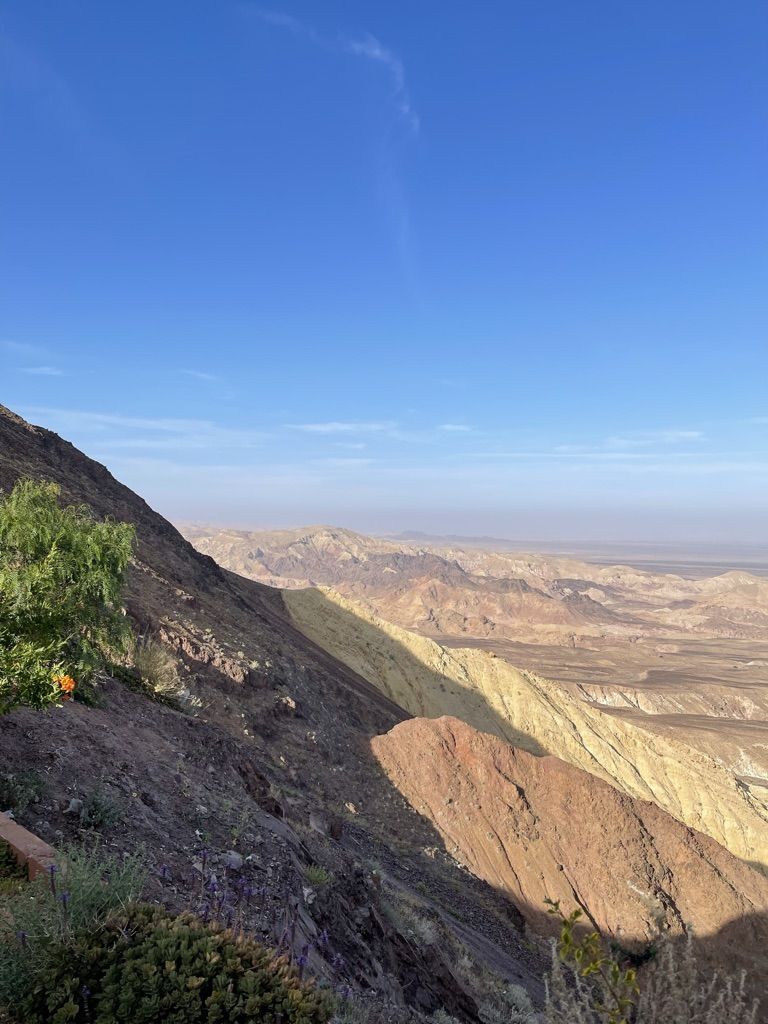
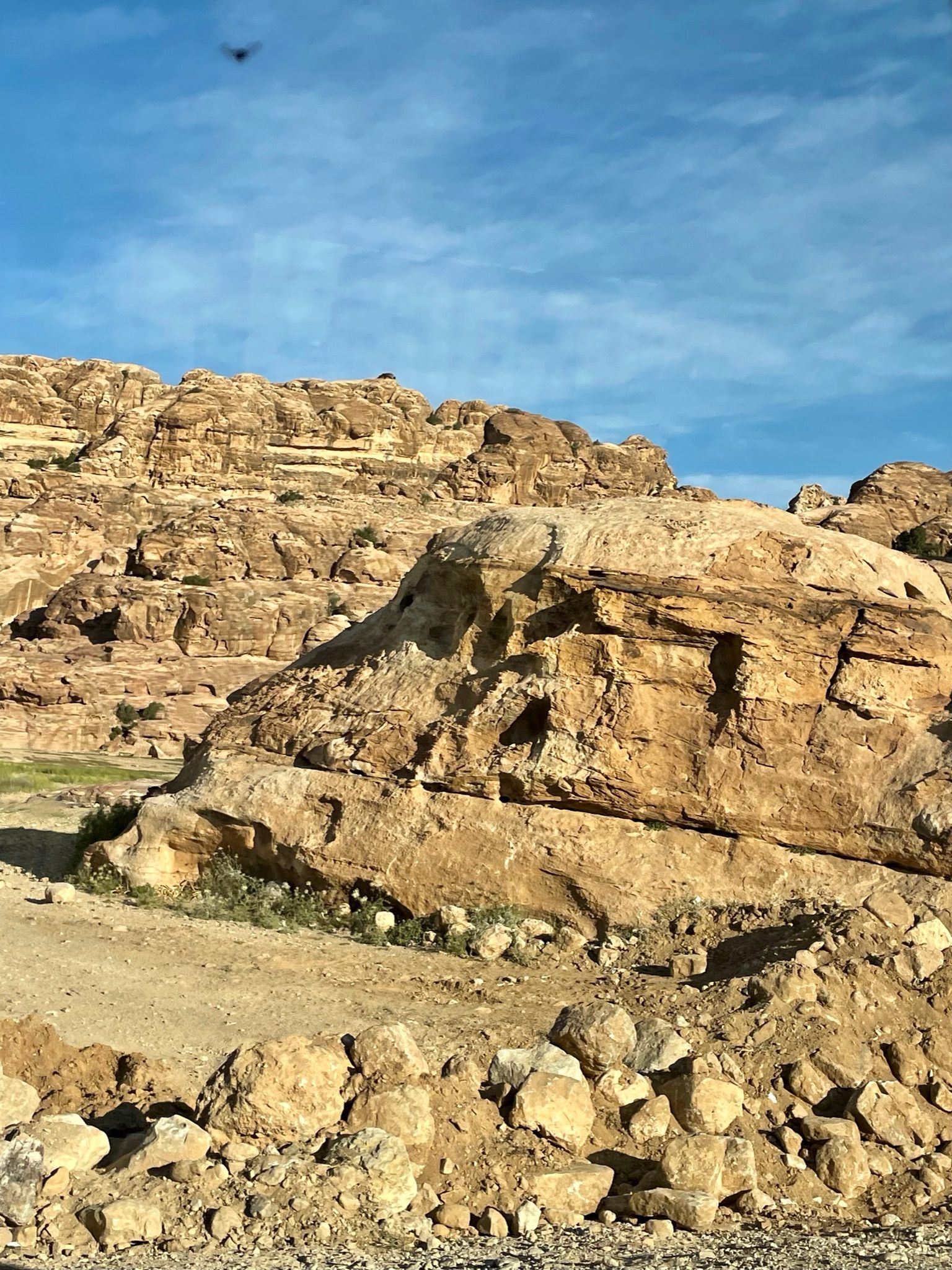
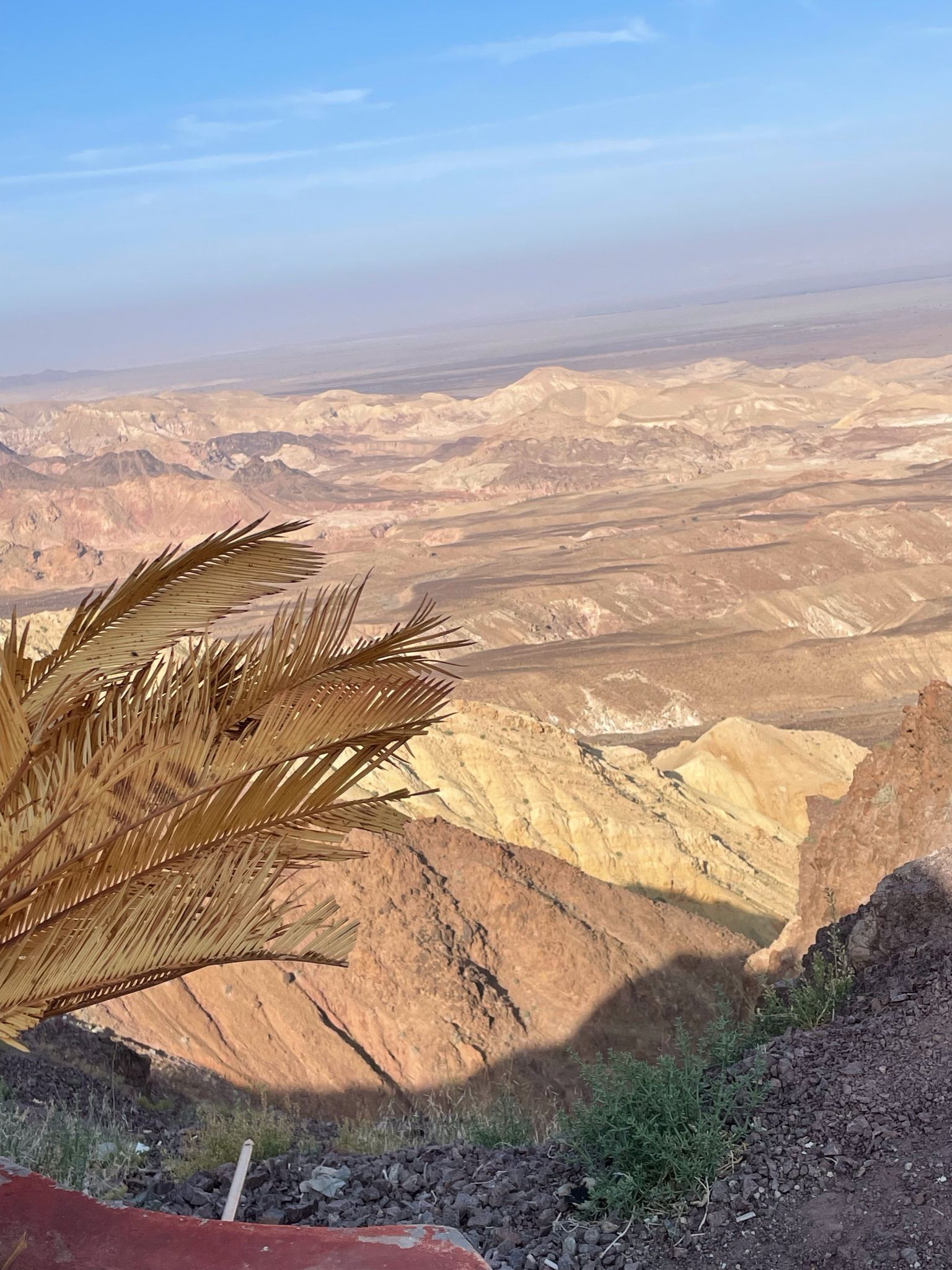 Our first rest stop was looking across the Jordan River Valley, posing on a homemade swing. The very primitive facilities were across the street. (Speaking of which, there are mostly western toilets here, but most with no tp except your own which never goes into the toilet but
into a side wastebasket. Hand drying, if there is enough water to wash is not unusual. Hotels are much better with good quality, and if you’re lucky, enough tp.
Our first rest stop was looking across the Jordan River Valley, posing on a homemade swing. The very primitive facilities were across the street. (Speaking of which, there are mostly western toilets here, but most with no tp except your own which never goes into the toilet but
into a side wastebasket. Hand drying, if there is enough water to wash is not unusual. Hotels are much better with good quality, and if you’re lucky, enough tp. 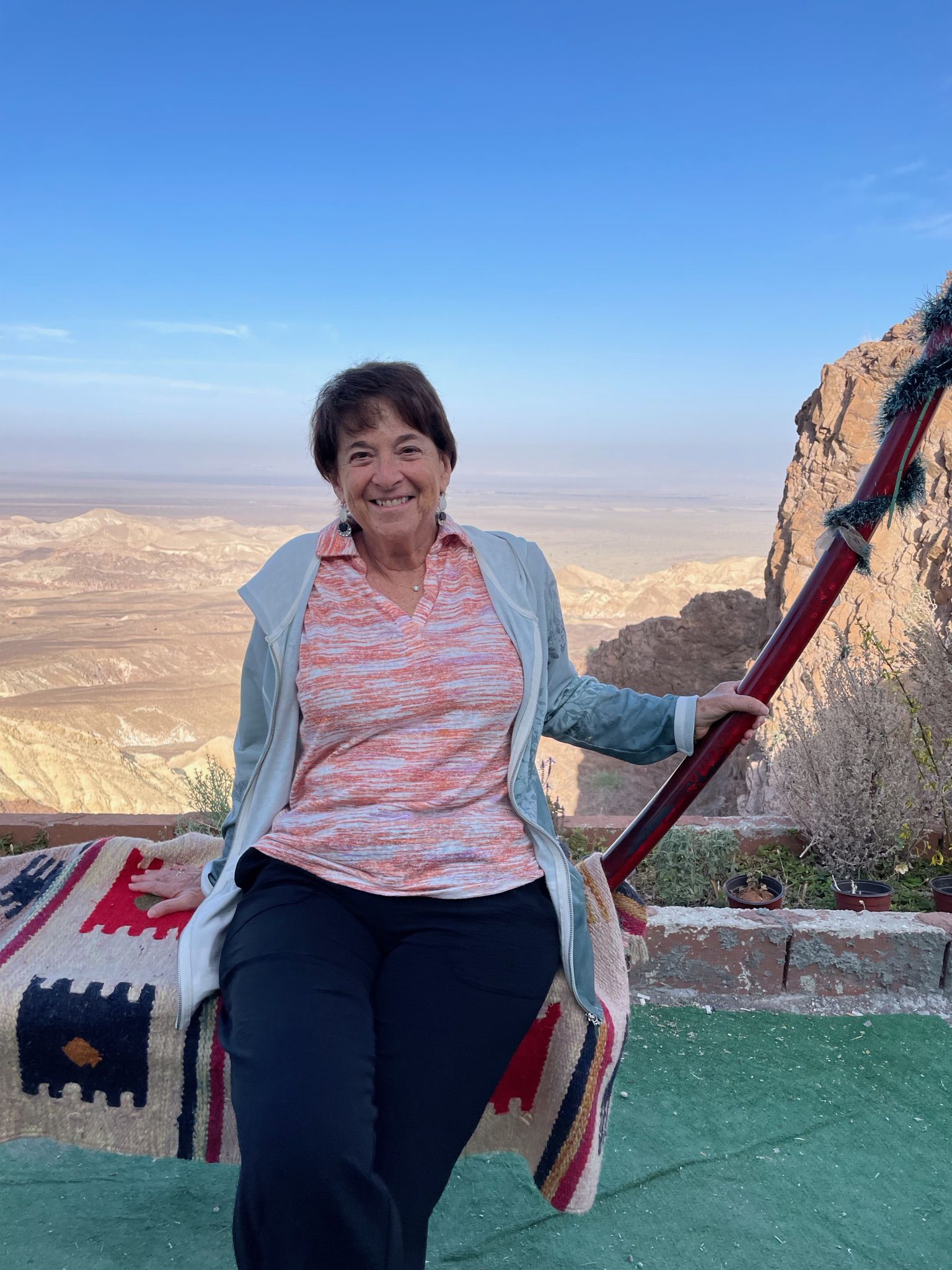 Along the King’s Highway, we passed camel caravans, trucks carrying fresh produce and saw small farms, settlements and the salt drying from the Dead Sea to make potash.
Along the King’s Highway, we passed camel caravans, trucks carrying fresh produce and saw small farms, settlements and the salt drying from the Dead Sea to make potash. 
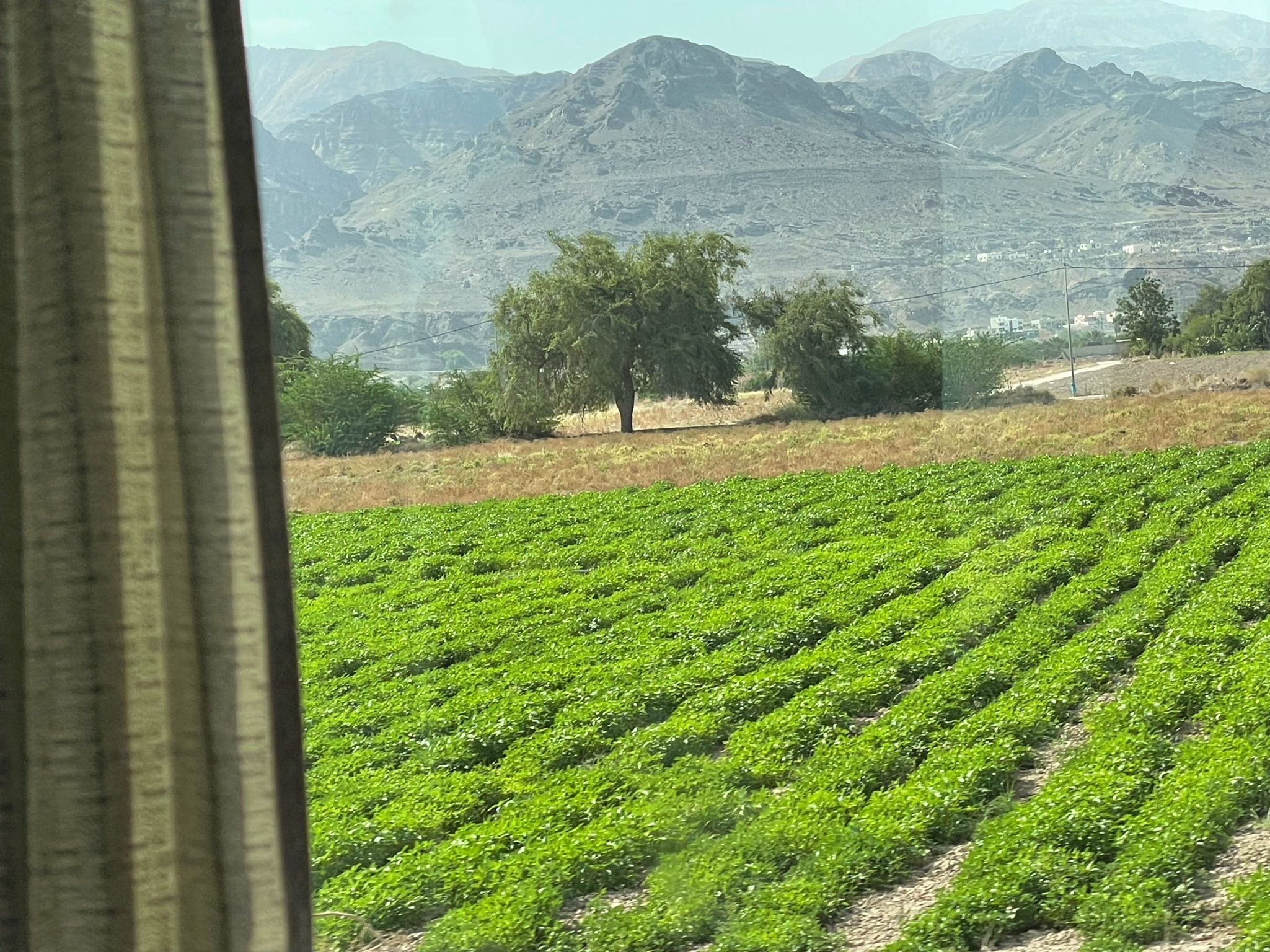
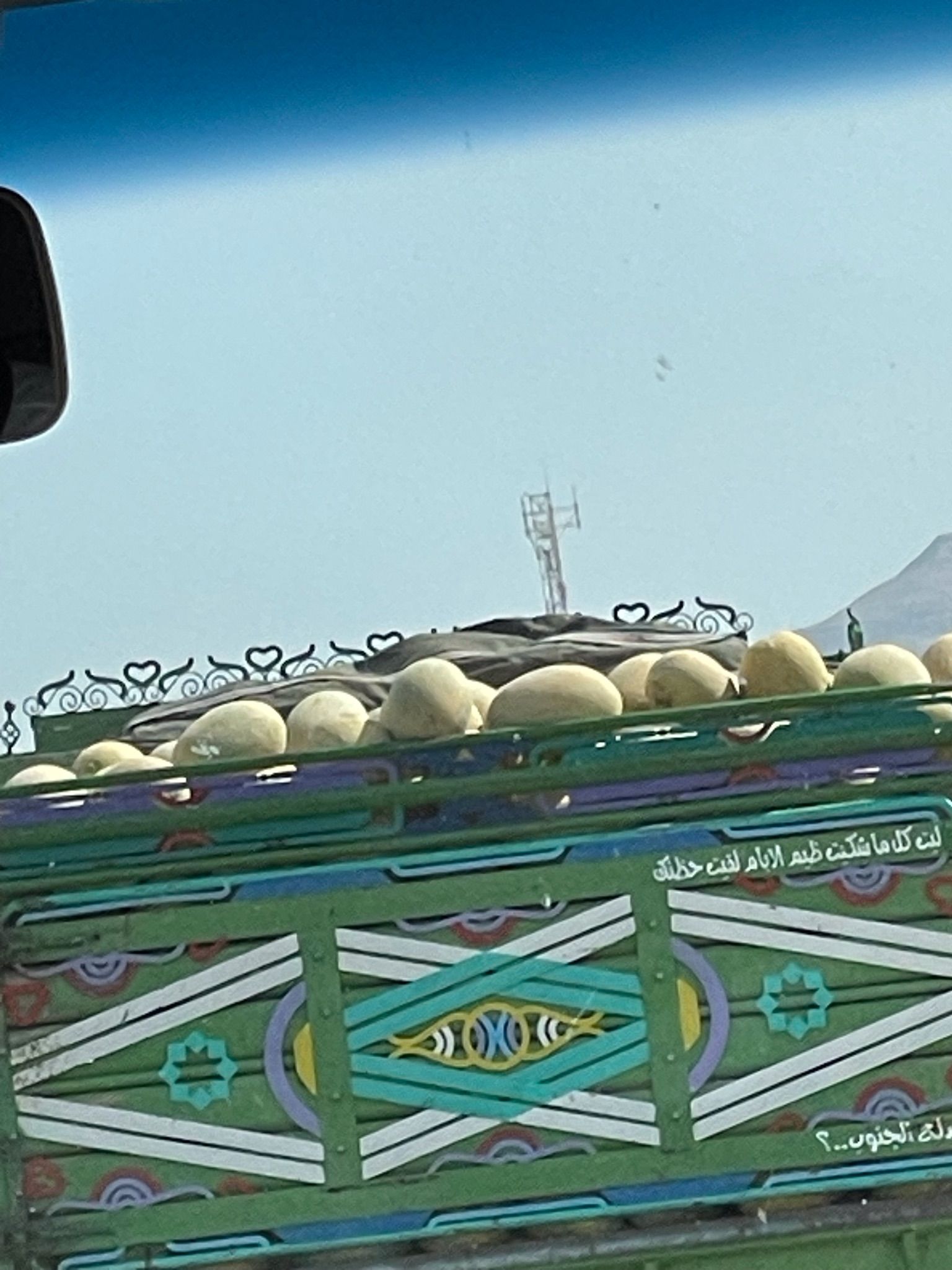
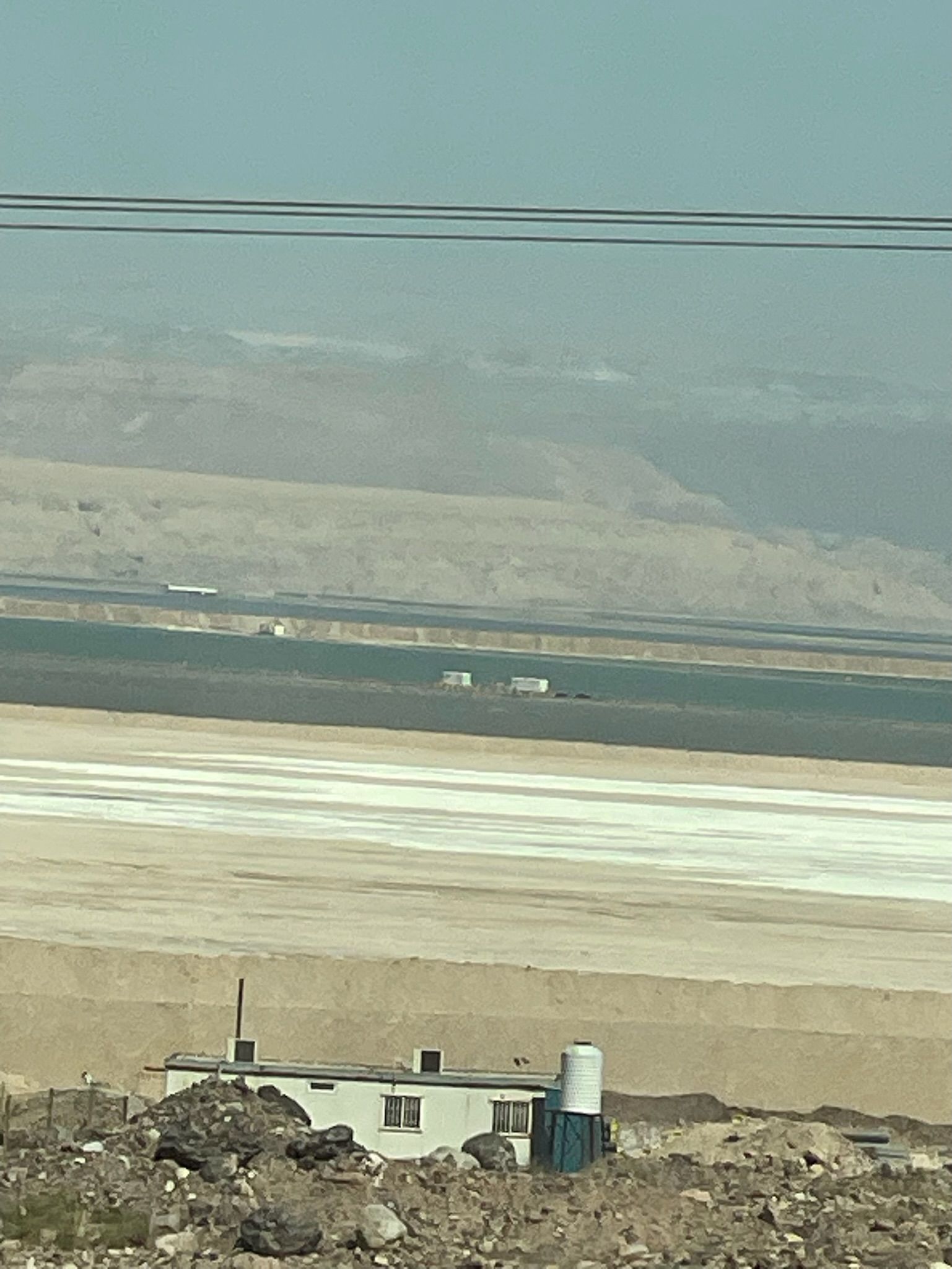
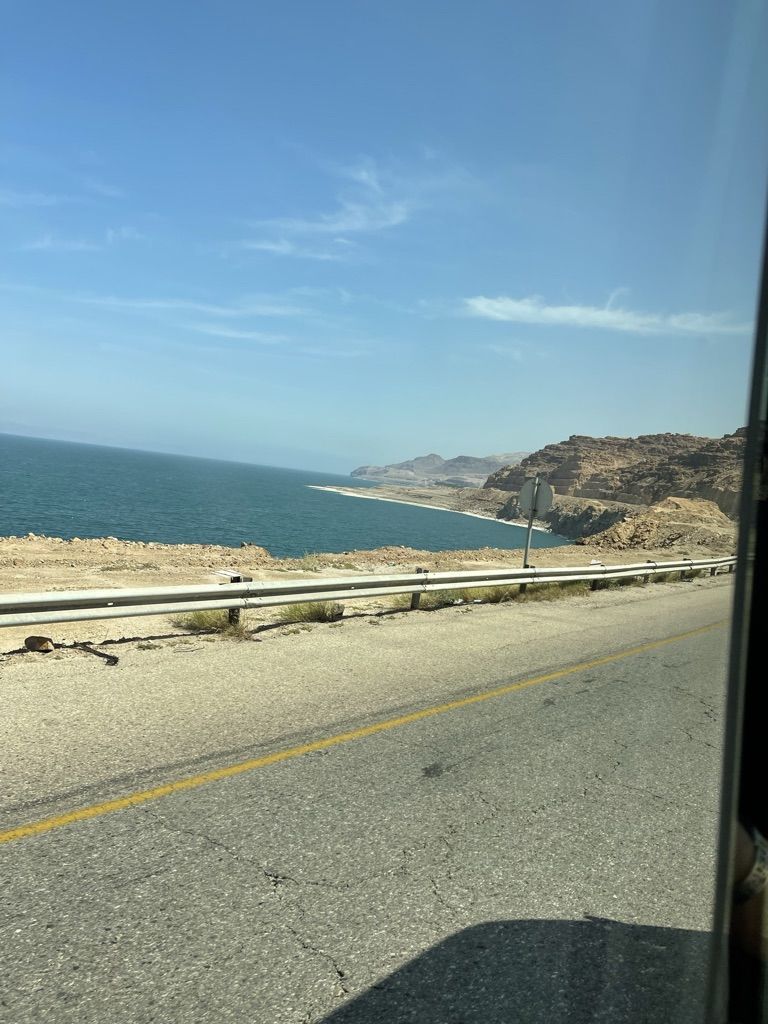 Patience was the word of the day. We arrived at the
Jordanian/Israeli border at the King Hussein bridge at about 11:15. In some ways, it reminded me of being in China where there were some kind of formalities many times over,with each government official or entity having its moment in the sun. Passports were collected three times.
Patience was the word of the day. We arrived at the
Jordanian/Israeli border at the King Hussein bridge at about 11:15. In some ways, it reminded me of being in China where there were some kind of formalities many times over,with each government official or entity having its moment in the sun. Passports were collected three times.
At 12:00 we said goodbye to Mohamed and our bus driver. You need a separate driver to drive across the bridge into Israel, passing through two checkpoints. Our driver finally arrived at about 12:45. The first checkpoint took another 40 minutes, then second one about ten. The King Hussein bridge finally becomes the Allenby bridge and at that point, we were officially in Israel! Mohamed had good connections because we somehow avoided the long security and luggage search in Israel. At about 1:45 we finally met our new guide, Ibrahim and started our two hour plus drive to Haifa.
60% of Israel is arid desert which leaves 40% as cultivated farmland and cities or small towns. The entire size of Israel is about the size of New Jersey. Leading industries of Israel include 1) military technology, 2)agricultural products 3) software 4)diamonds. It is interesting to note that tourism doesn’t even rank in the top ten.
We passed beautiful green areas of palm date plantations (a huge crop here - and very delicious!), bananas, tomatoes and watermelons as well as some wheat fields and a coal-based electric power plant. 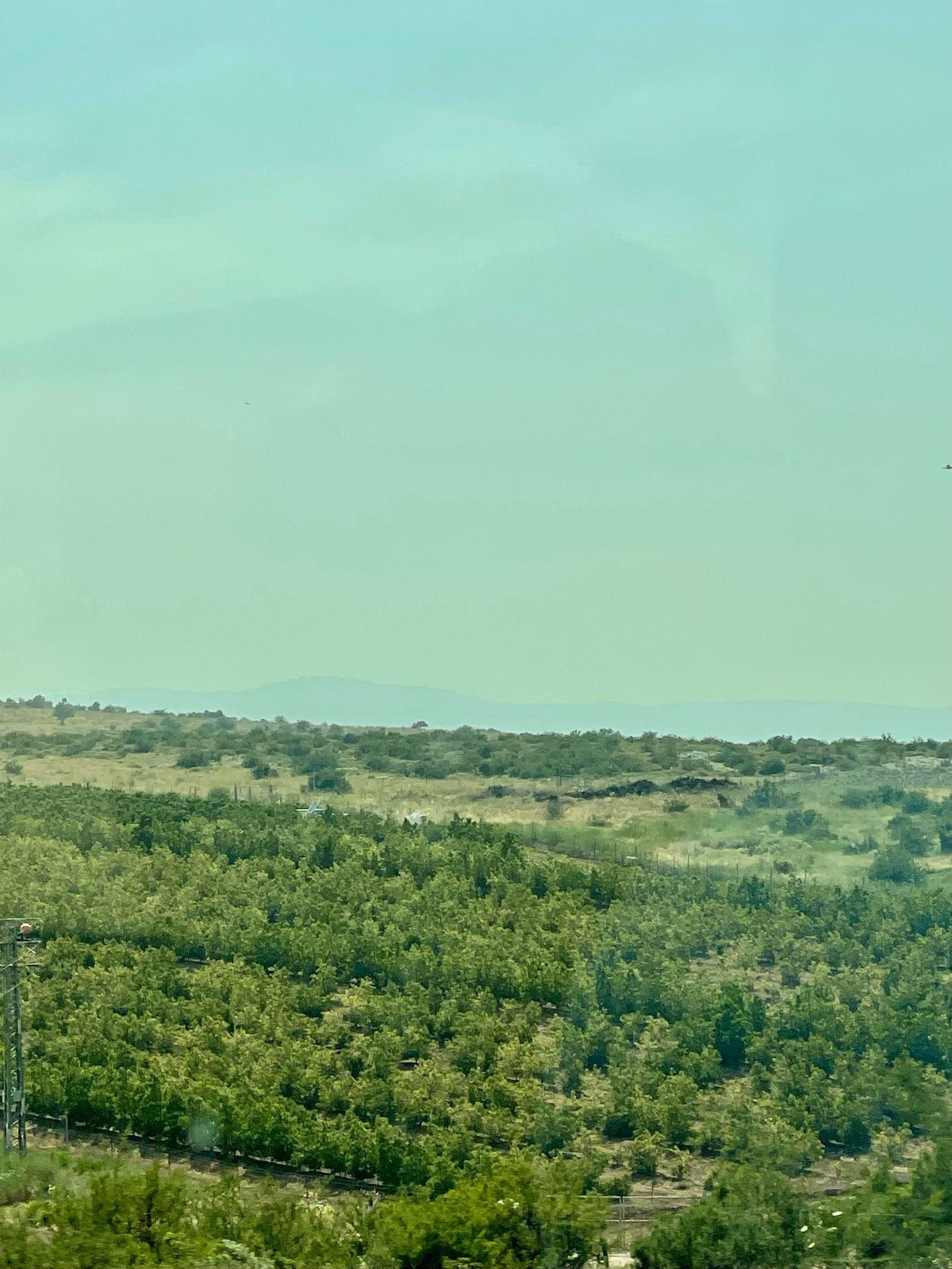
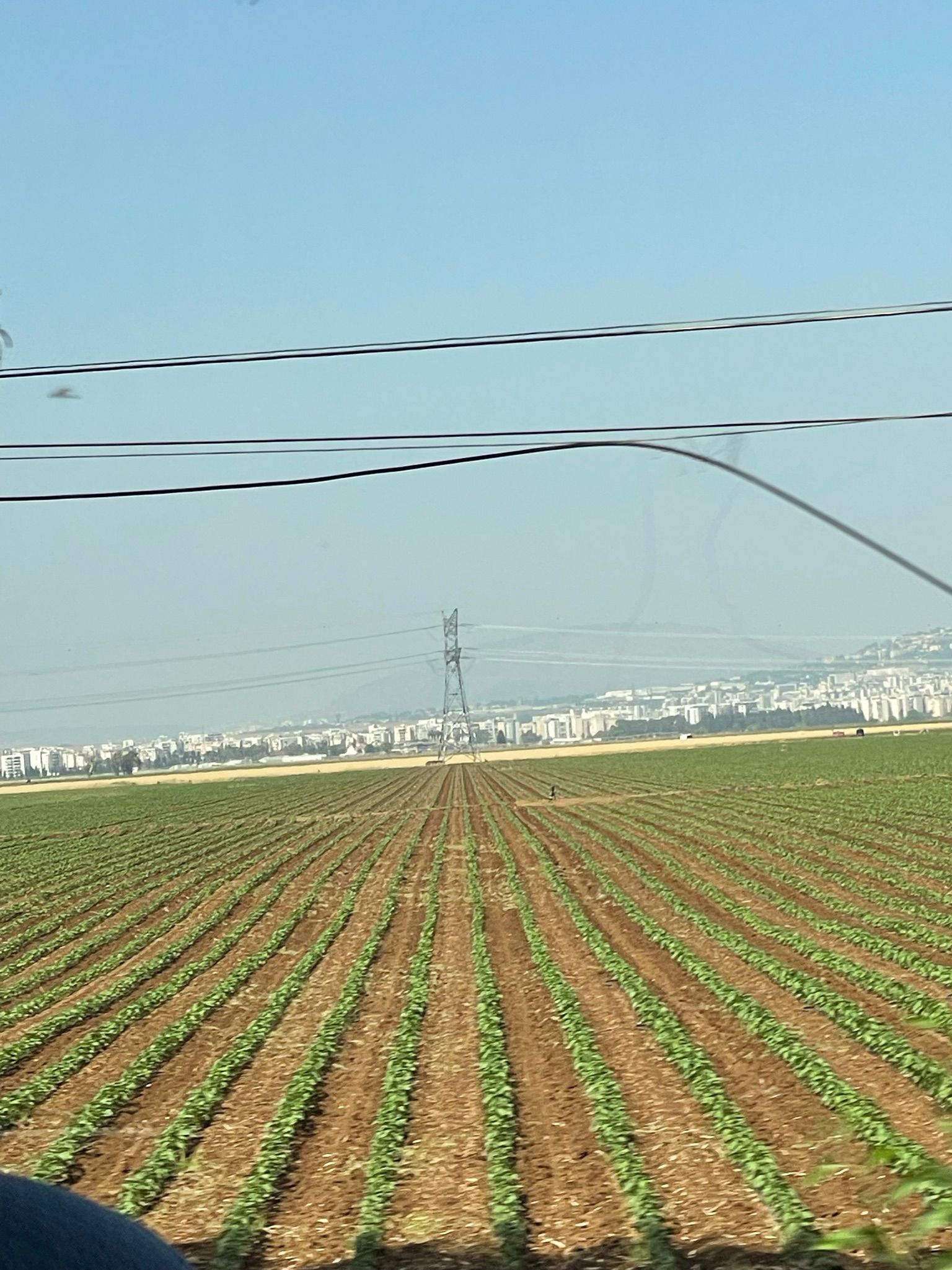
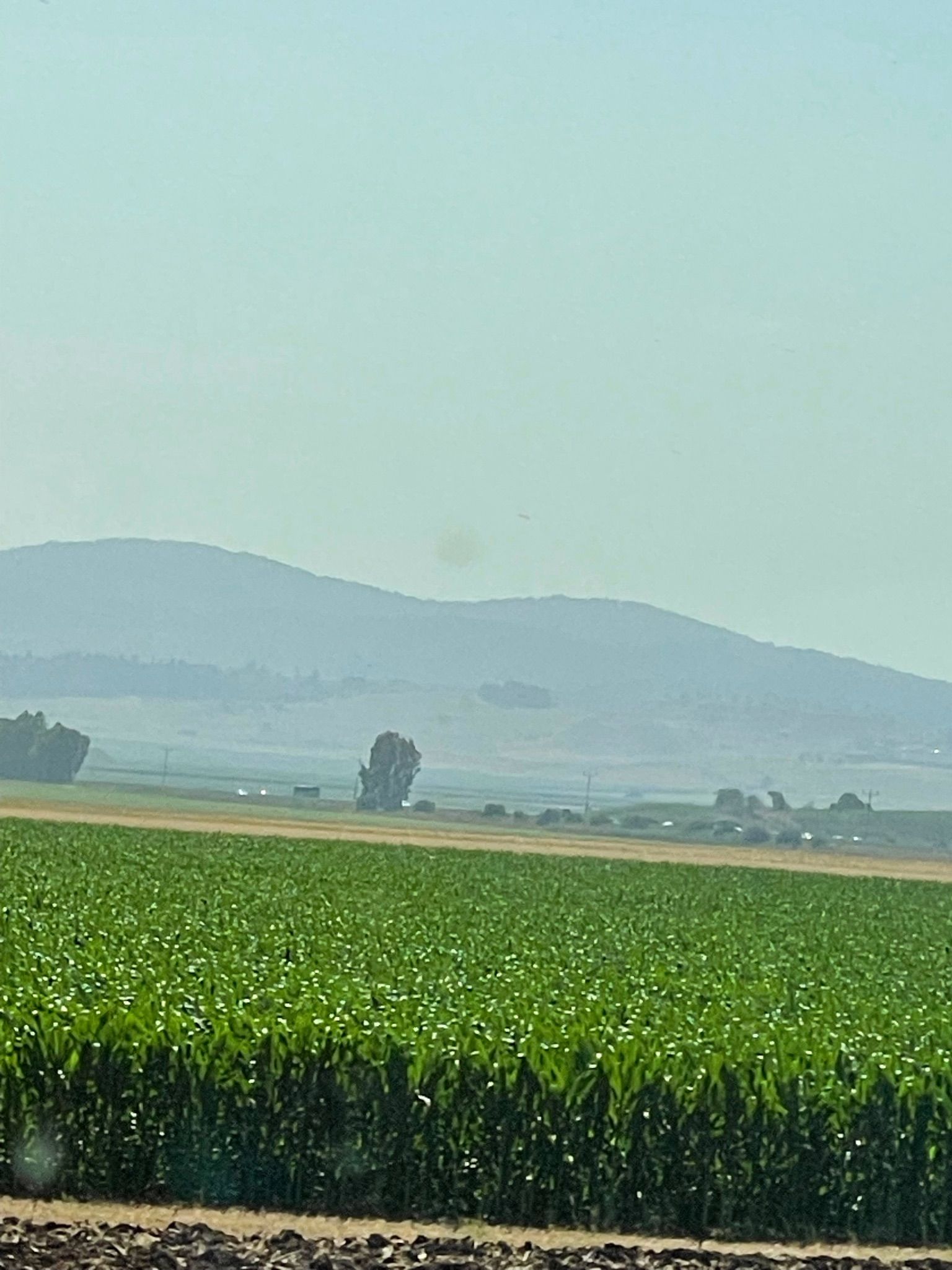
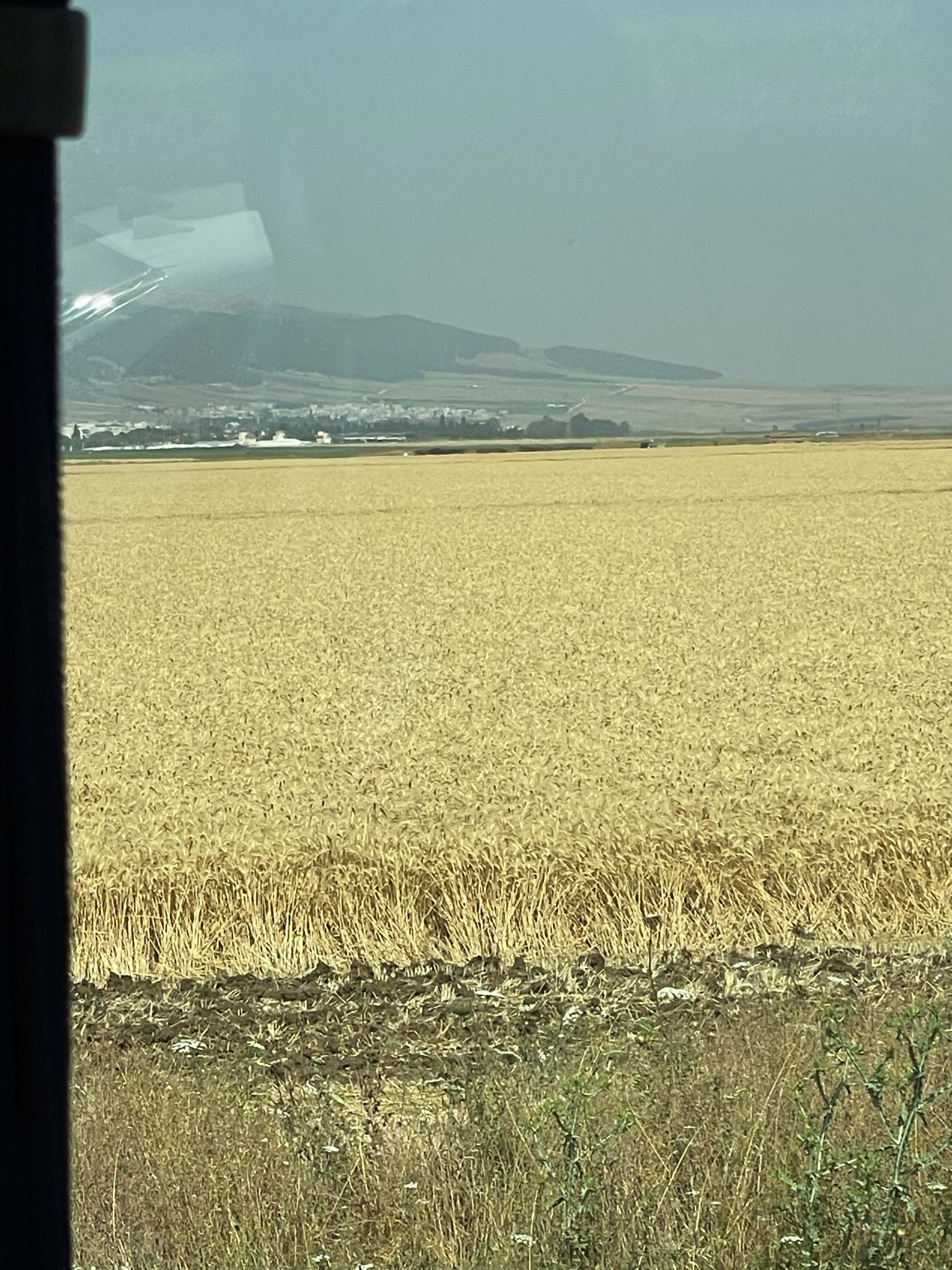 Ibrahim, a native Arab Christian Israeli, has an intense style, very direct and concise and is not afraid to tackle any subject. He has already shared with us his thoughts on the political situation and the current attacks from Gaza into Israel. The media, on all sides, has been hyping this, but the rockets have all been destroyed by Israeli forces and a cease fire was declared two days ago.
But evidently it did scare away some tour groups who cancelled , so he thanked us for coming.
Ibrahim, a native Arab Christian Israeli, has an intense style, very direct and concise and is not afraid to tackle any subject. He has already shared with us his thoughts on the political situation and the current attacks from Gaza into Israel. The media, on all sides, has been hyping this, but the rockets have all been destroyed by Israeli forces and a cease fire was declared two days ago.
But evidently it did scare away some tour groups who cancelled , so he thanked us for coming.
Our day ended with checking into our modern boutique hotel, the Schumacher, in an area known as the German colony in Haifa. We had a wonderful conversation with Ibrahim who joined us halfway through our dinner at a local restaurant.
#published #evernote
May 15, 2023
2023 - Israel and Jordan
Day 5: Petra!!
Petra is considered to be one of the new seven wonders of the world, and we eagerly anticipated coming here. To put it simply, it is something that must not be missed. It was the highlight of our trip thus far. 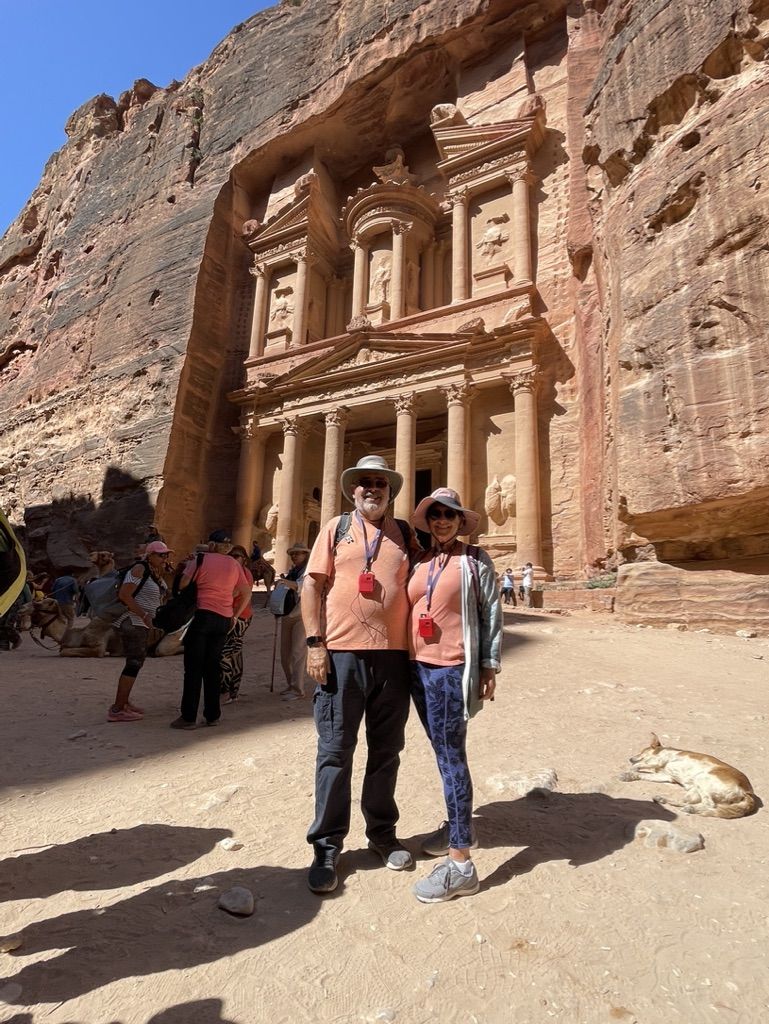 The ancient archeological city of Petra is located in southern Jordan about 300 kilometers south of Amman in the Al Sharah mountains. We left our hotel at 7 am and walked the 50 yards to the entrance— very nice!
The ancient archeological city of Petra is located in southern Jordan about 300 kilometers south of Amman in the Al Sharah mountains. We left our hotel at 7 am and walked the 50 yards to the entrance— very nice! 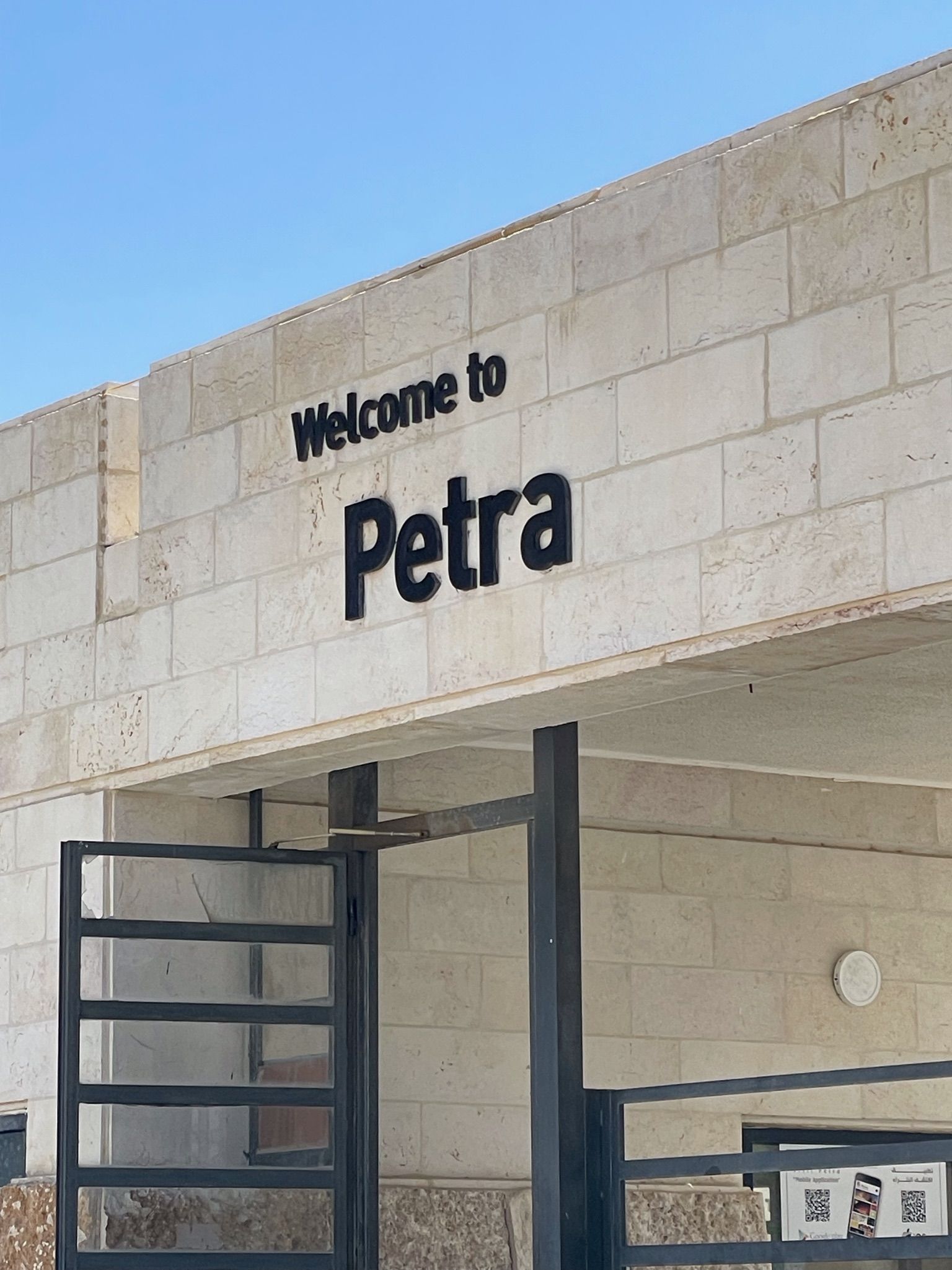 The first of hundreds of things that our guide Mohammad pointed out to us was way up— Aaron’s grave at the top of a huge hill. It is white. So, after seeing Moses’s last known place yesterday, Aaron’s today, my question to Mohammed was “ and where is Miriam buried?” Inquiring minds want to know. He did not.
The first of hundreds of things that our guide Mohammad pointed out to us was way up— Aaron’s grave at the top of a huge hill. It is white. So, after seeing Moses’s last known place yesterday, Aaron’s today, my question to Mohammed was “ and where is Miriam buried?” Inquiring minds want to know. He did not. 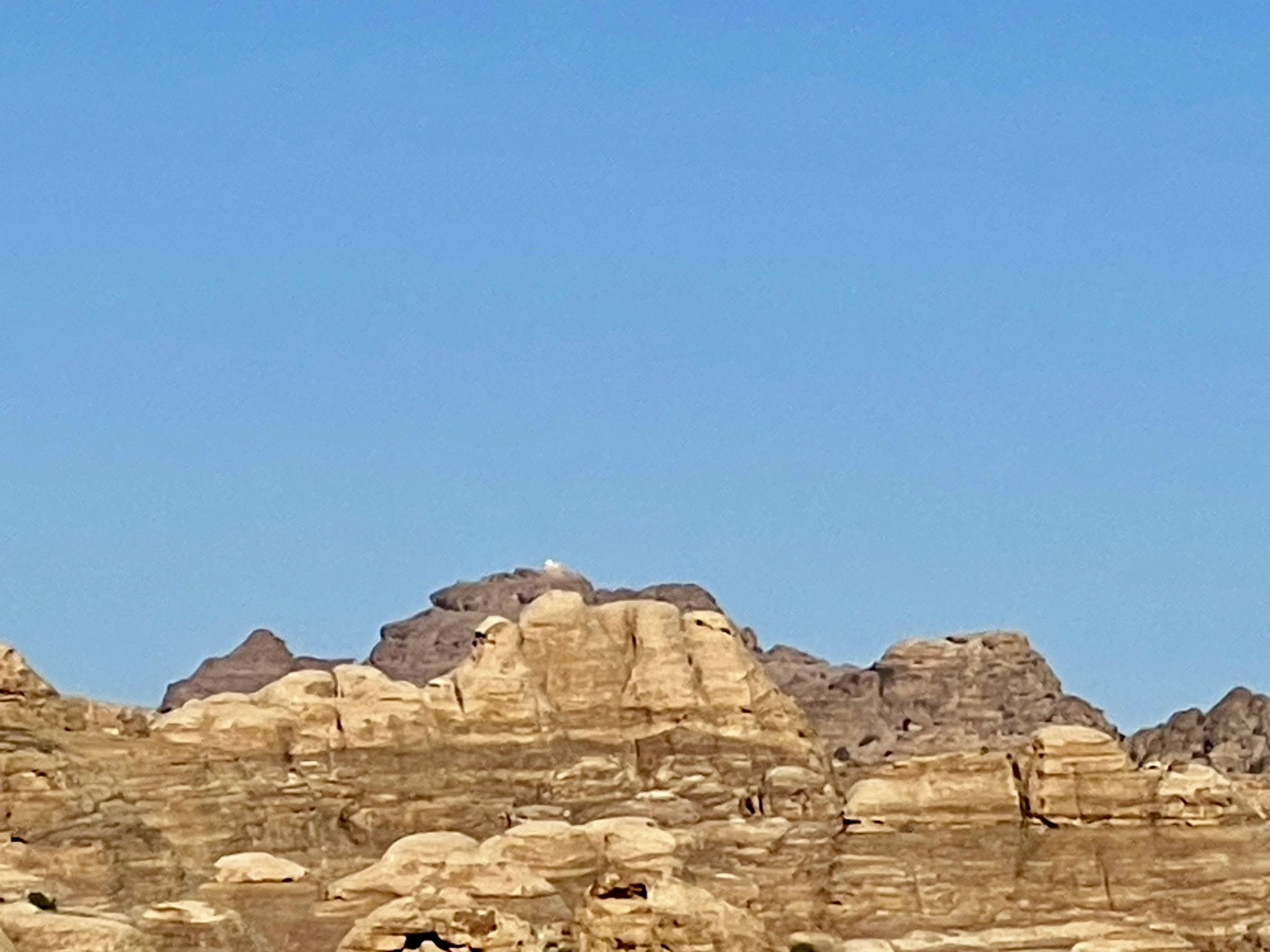 Petra (meaning “rock”) was
the Greek name. The modern Arabic name derives from the name of the river that flows down the valley—the Wadi Musa (River of Moses). It was the capital city of the Nabataeans, a nomadic tribe descended from the Maccabees who literally carved the city into the sandstone mountains. The prosperity of the Nabataean kingdom reached its peak between 9 BC and 40 AD but different groups kept carving and adding facades into the sandstone cliffs for several hundred years.
Petra (meaning “rock”) was
the Greek name. The modern Arabic name derives from the name of the river that flows down the valley—the Wadi Musa (River of Moses). It was the capital city of the Nabataeans, a nomadic tribe descended from the Maccabees who literally carved the city into the sandstone mountains. The prosperity of the Nabataean kingdom reached its peak between 9 BC and 40 AD but different groups kept carving and adding facades into the sandstone cliffs for several hundred years.
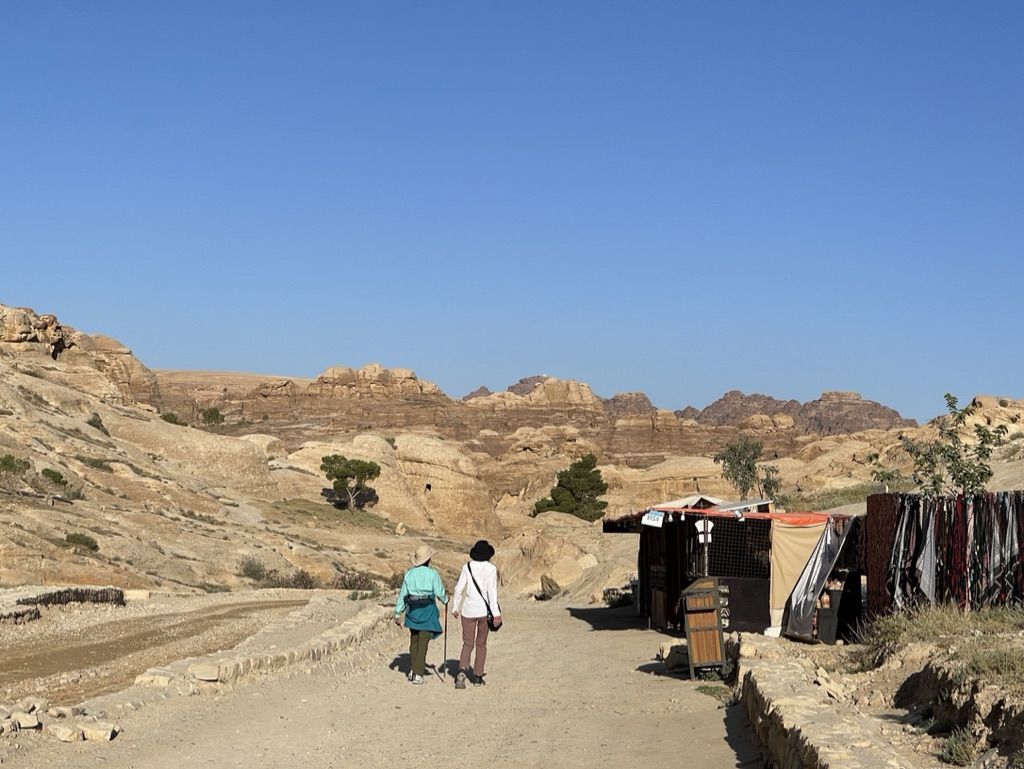
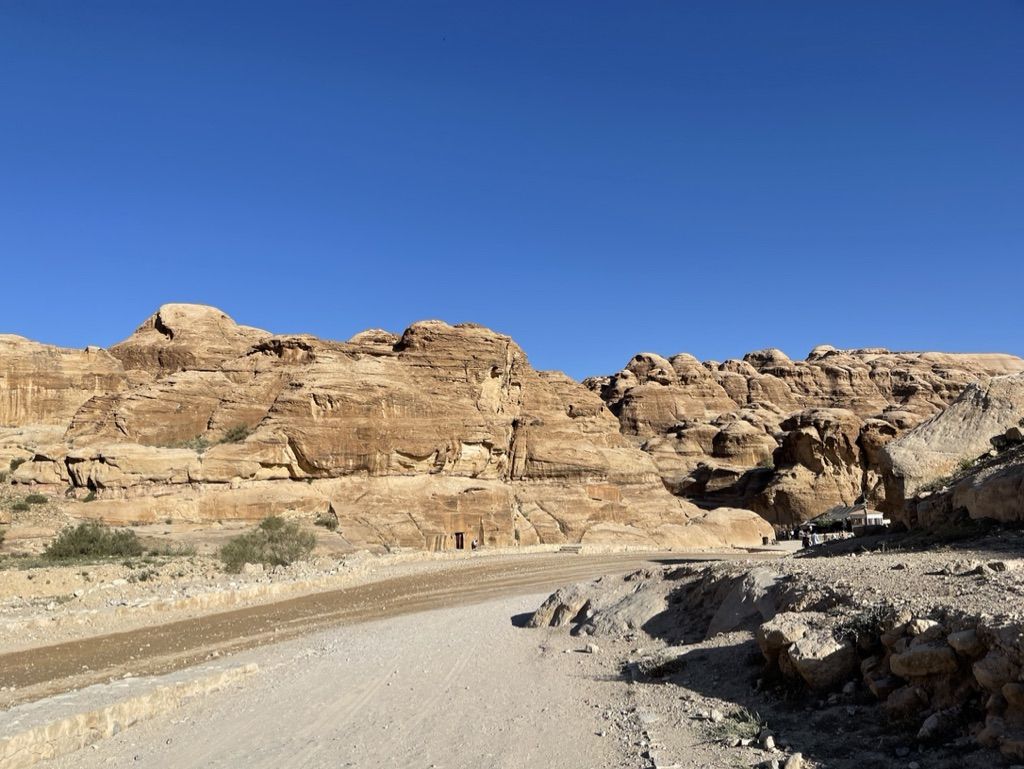 As we started our 6 mile walk through Petra, we passed hundreds of rock formations made more interesting by the streaks of morning sun hitting different sections.
As we started our 6 mile walk through Petra, we passed hundreds of rock formations made more interesting by the streaks of morning sun hitting different sections. 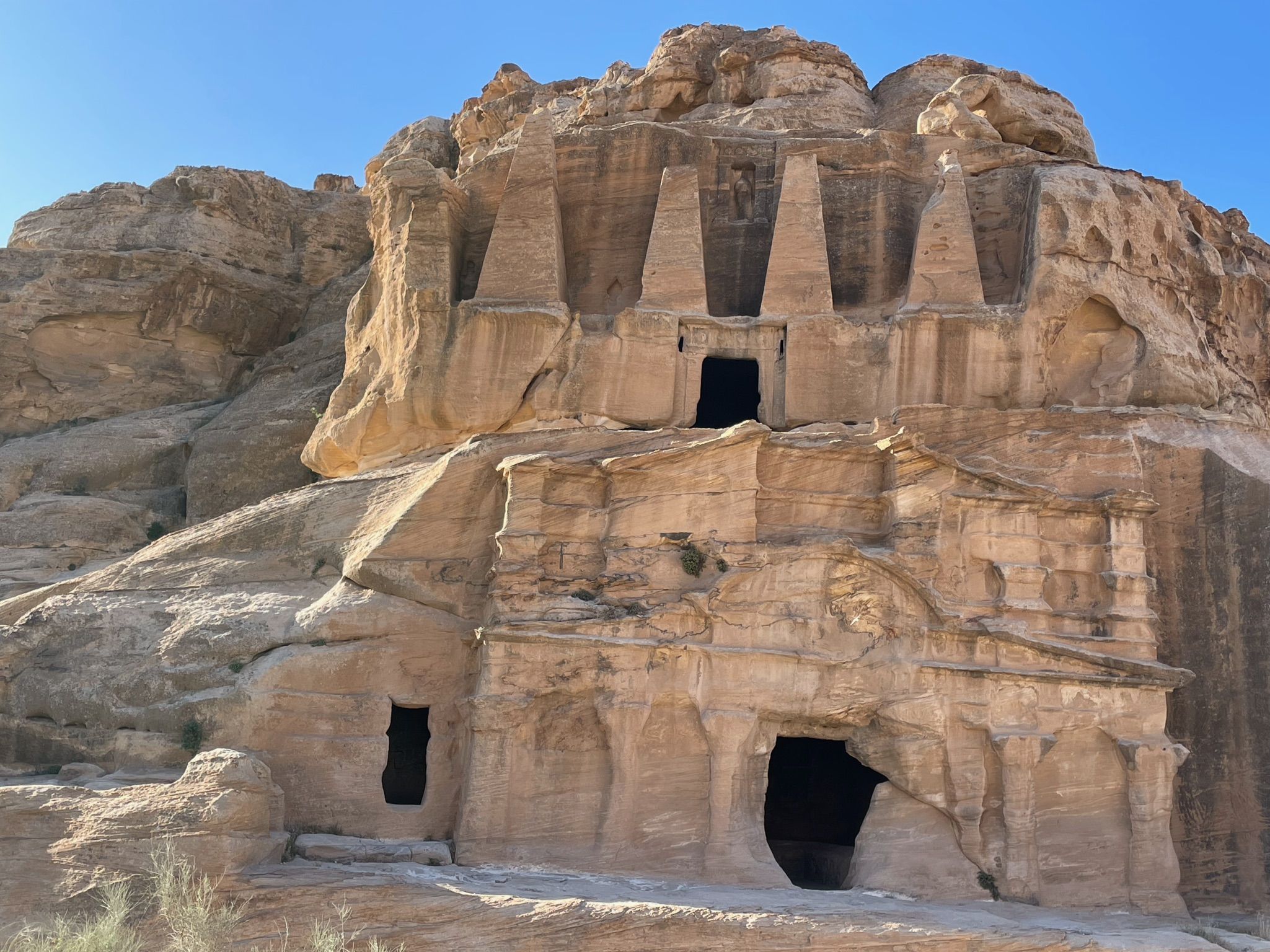
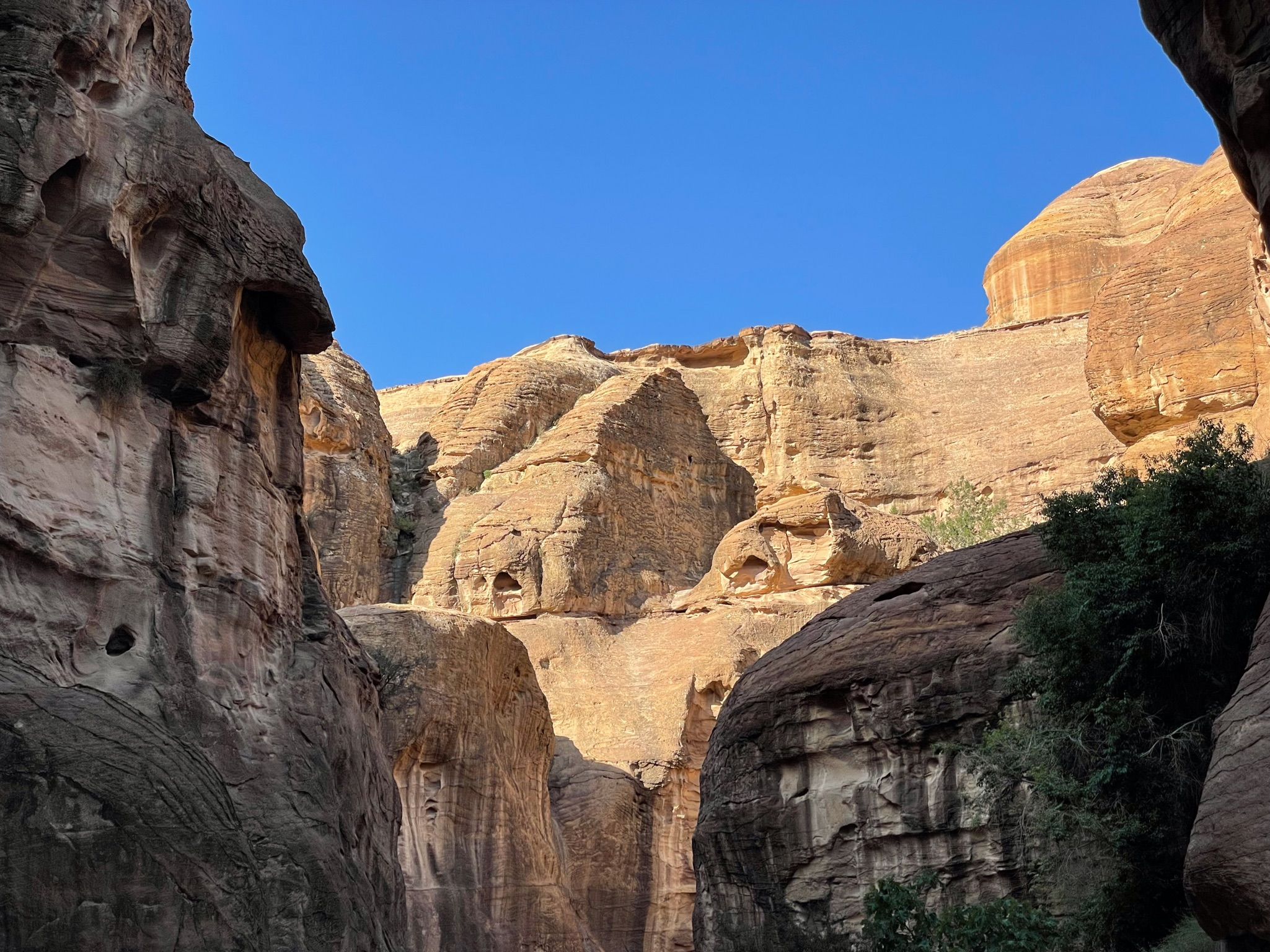 About ⅓ of a mile in, we reached a dam. A sophisticated system of aqueducts and pipes channeled water along the sides and sometimes above to deliver water to the city, but the dam was built to protect the valley from flash floods.
About ⅓ of a mile in, we reached a dam. A sophisticated system of aqueducts and pipes channeled water along the sides and sometimes above to deliver water to the city, but the dam was built to protect the valley from flash floods. 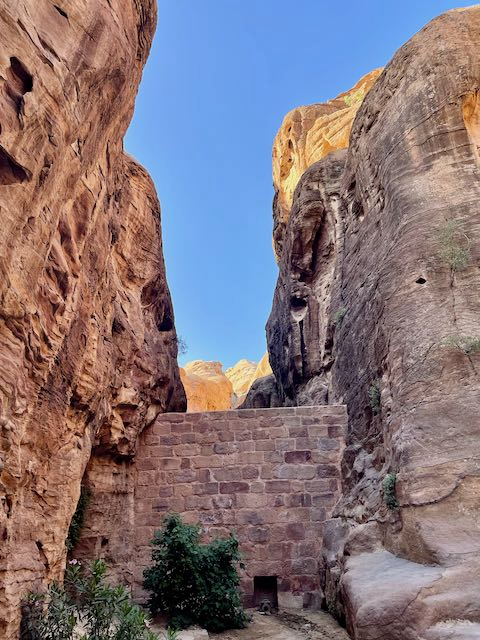
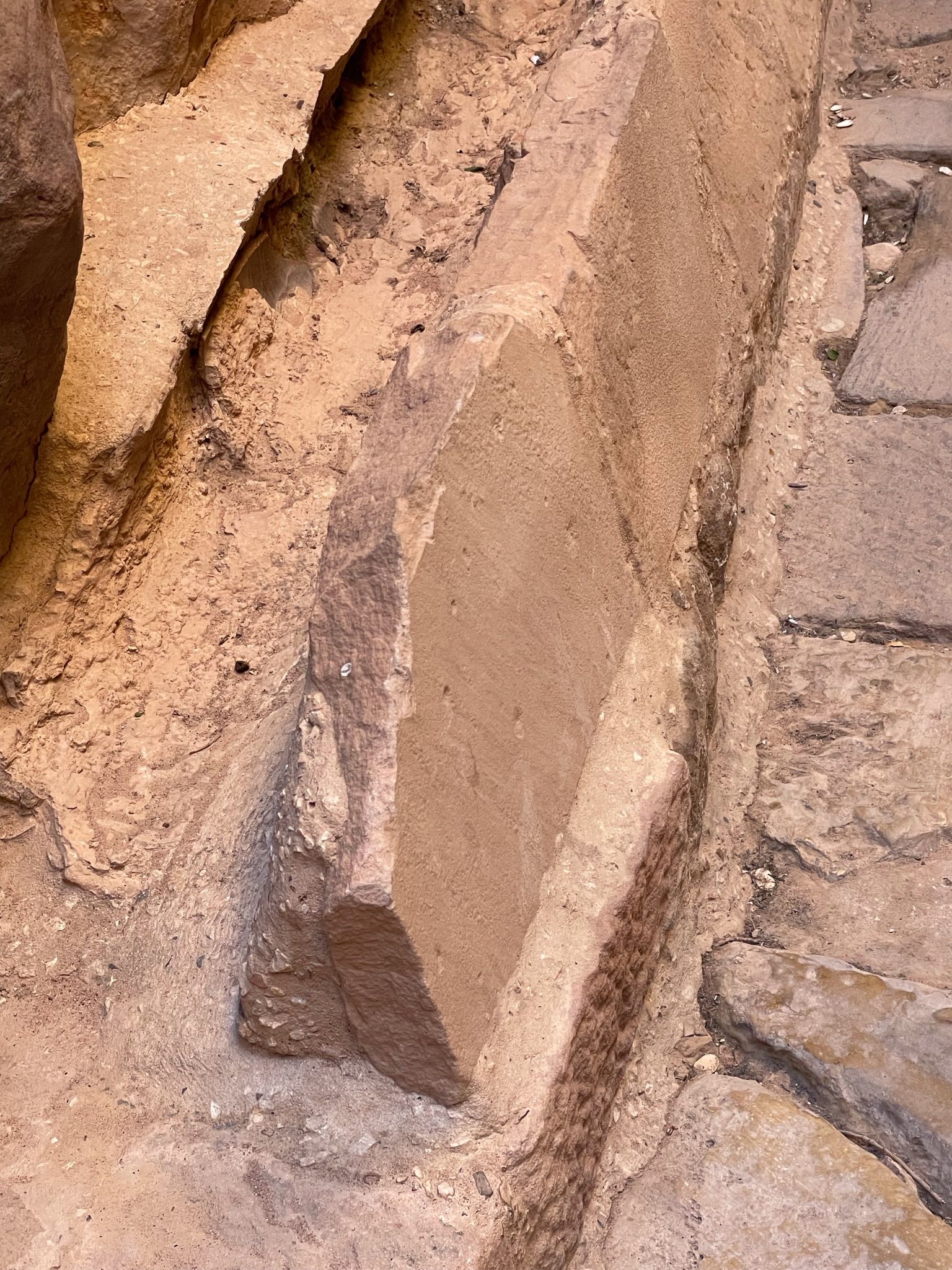 A narrow gorge called the Siq is 1.2 km long and presents a dramatic entry into the Treasury. It reminded us of Antelope Canyon in Arizona.
A narrow gorge called the Siq is 1.2 km long and presents a dramatic entry into the Treasury. It reminded us of Antelope Canyon in Arizona. 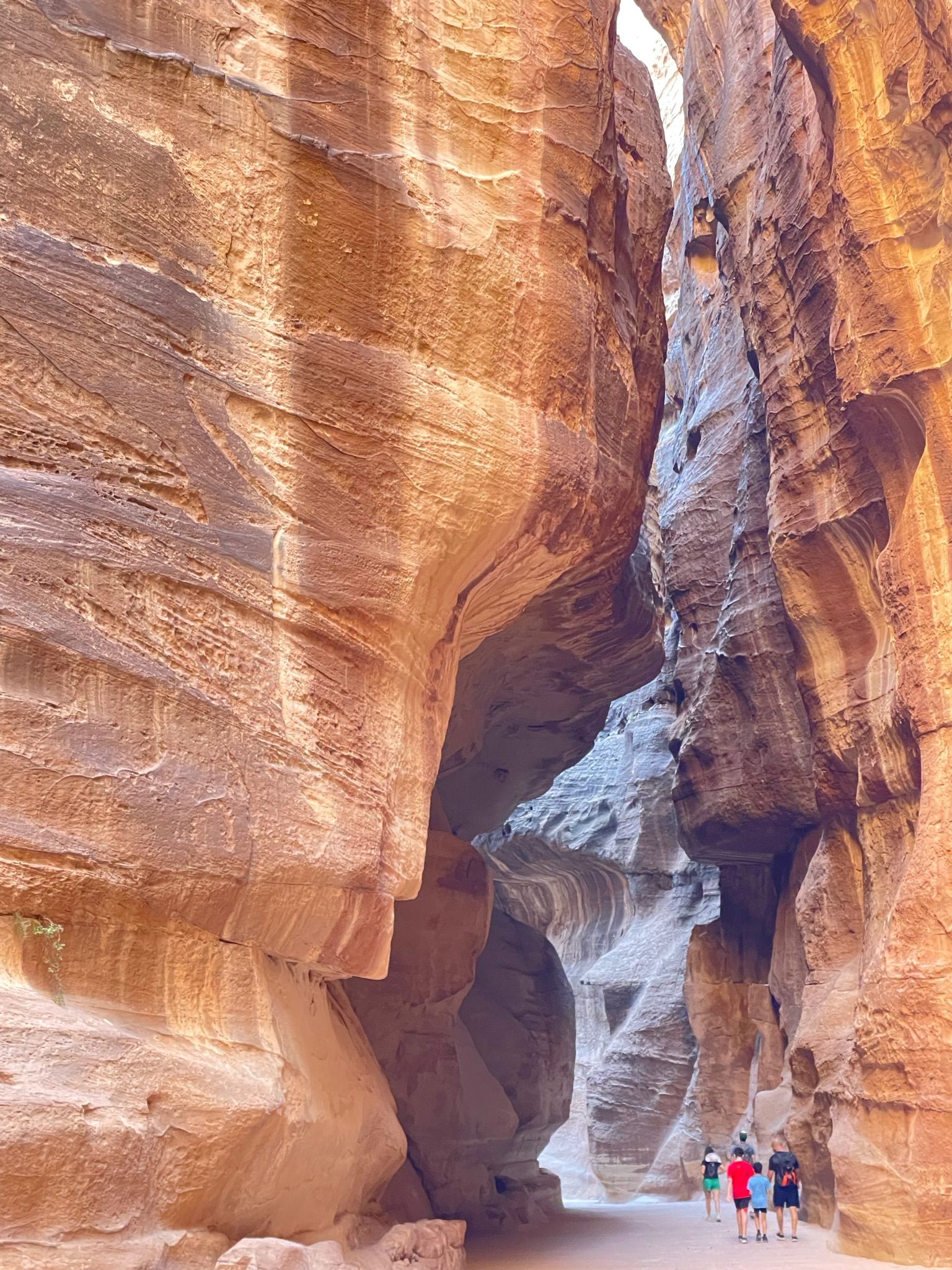
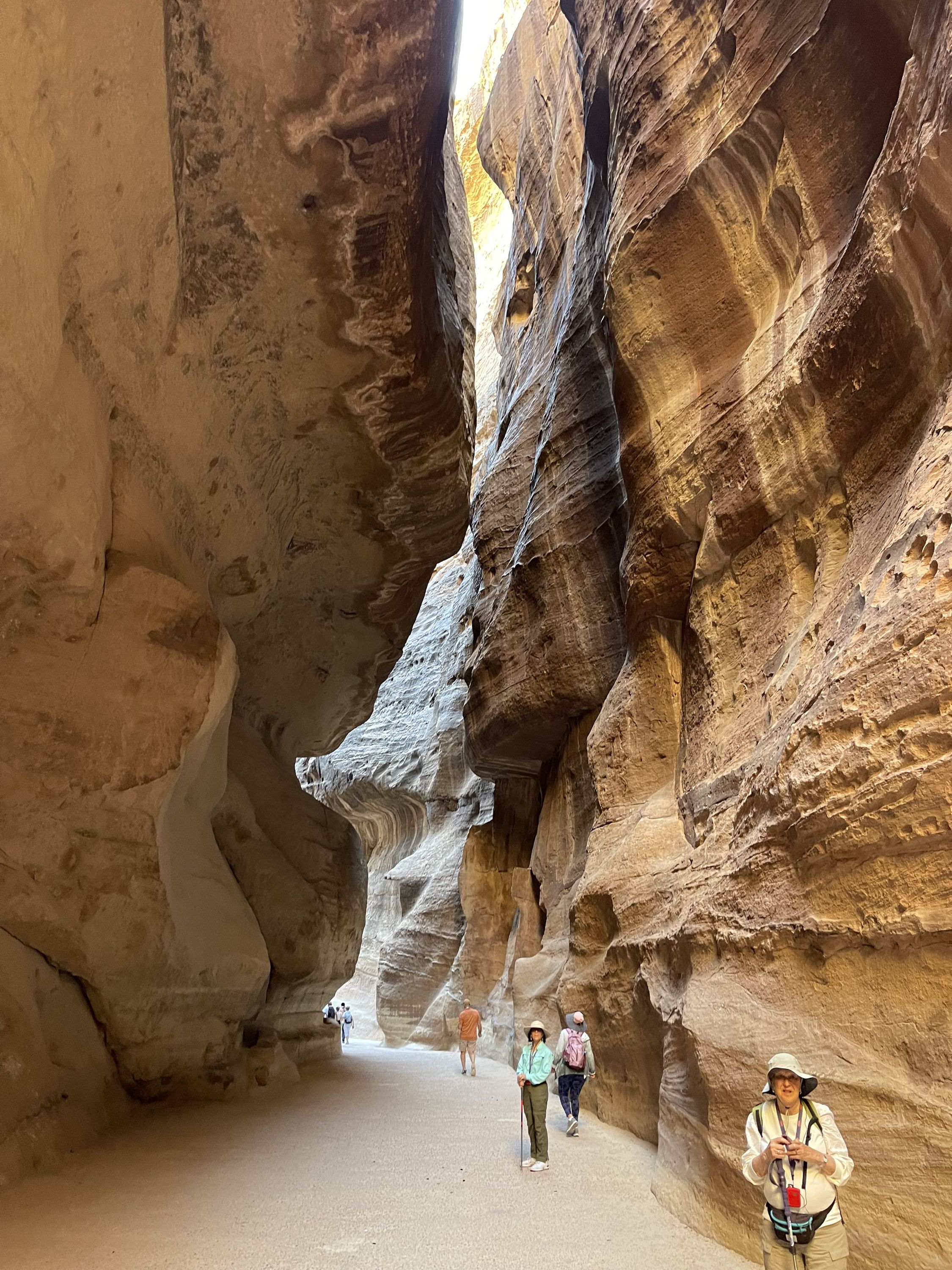
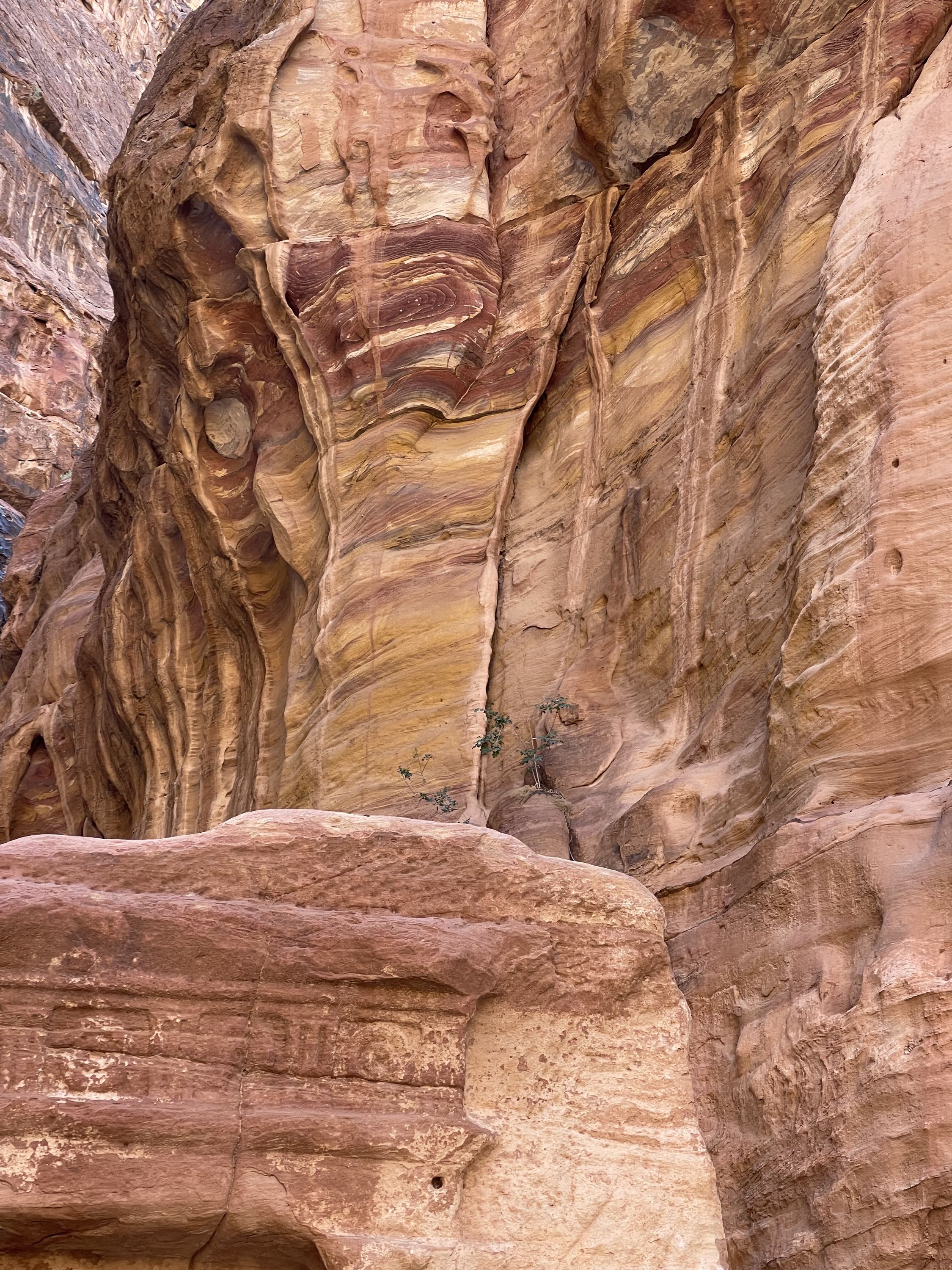
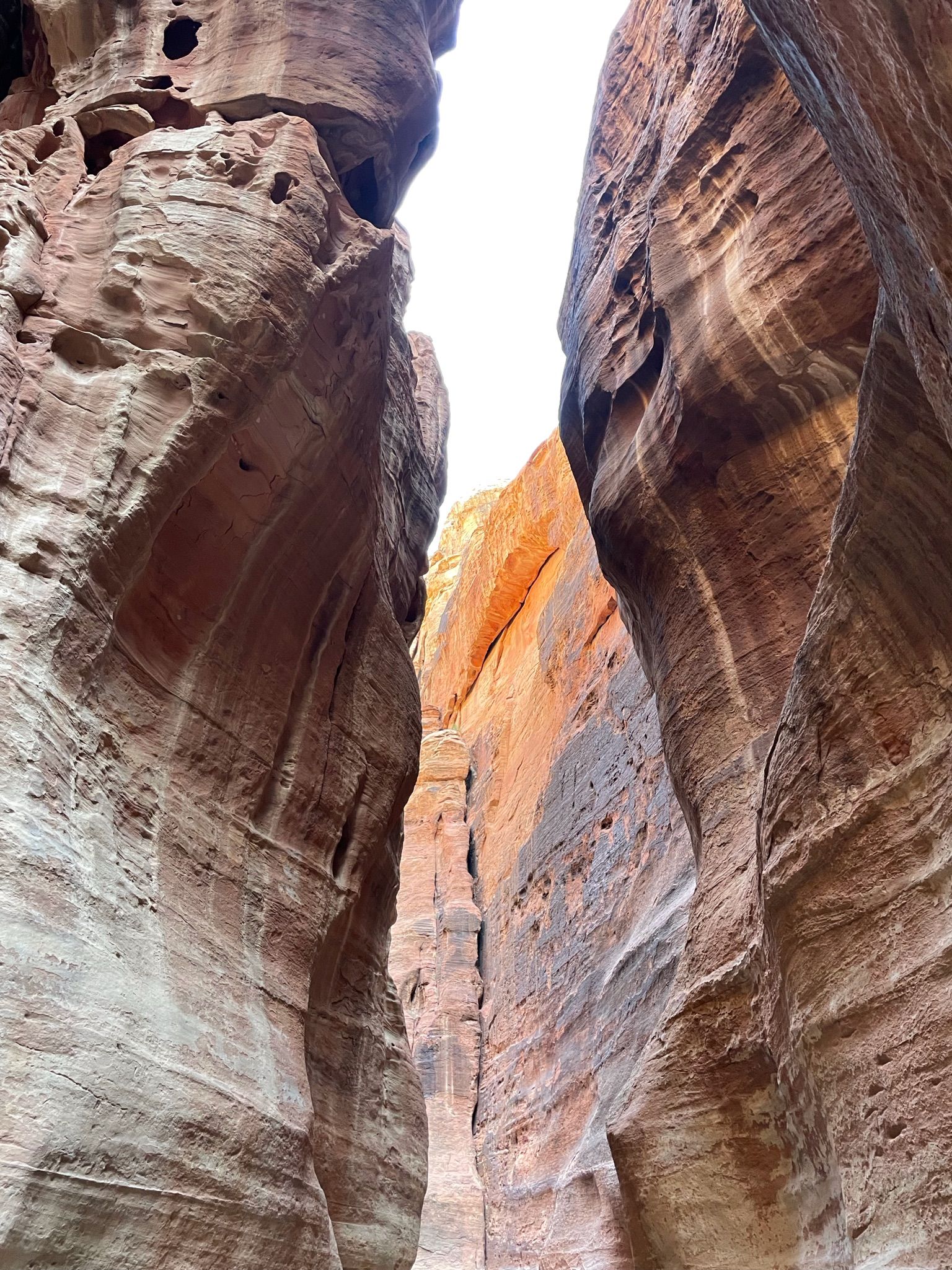 The Siq opens up into Petra’s most famous and magnificent structure called The Treasury, so named from a legend says that an Egyptian Pharaoh built it to house his treasure. It is almost 40 meters high and crowned by a funerary urn on top of the Corinthian columns. Even this early in the morning, it was packed with tourists, as well as donkeys, camels and golf carts to aid the weary travelers in getting to the other parts of the site. You might remember seeing it in “Indiana Jones and The Last Crusade”.
The Siq opens up into Petra’s most famous and magnificent structure called The Treasury, so named from a legend says that an Egyptian Pharaoh built it to house his treasure. It is almost 40 meters high and crowned by a funerary urn on top of the Corinthian columns. Even this early in the morning, it was packed with tourists, as well as donkeys, camels and golf carts to aid the weary travelers in getting to the other parts of the site. You might remember seeing it in “Indiana Jones and The Last Crusade”.
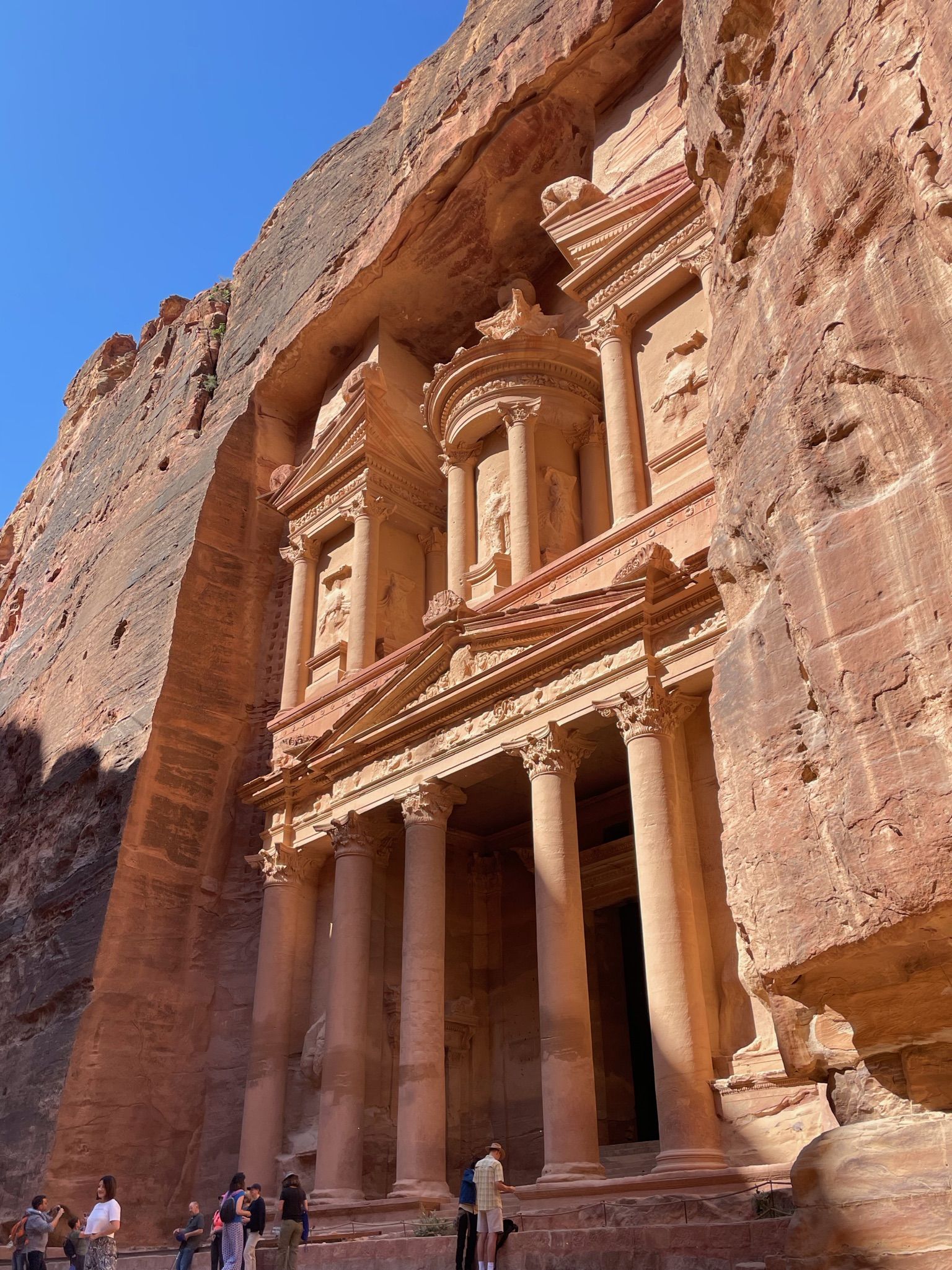
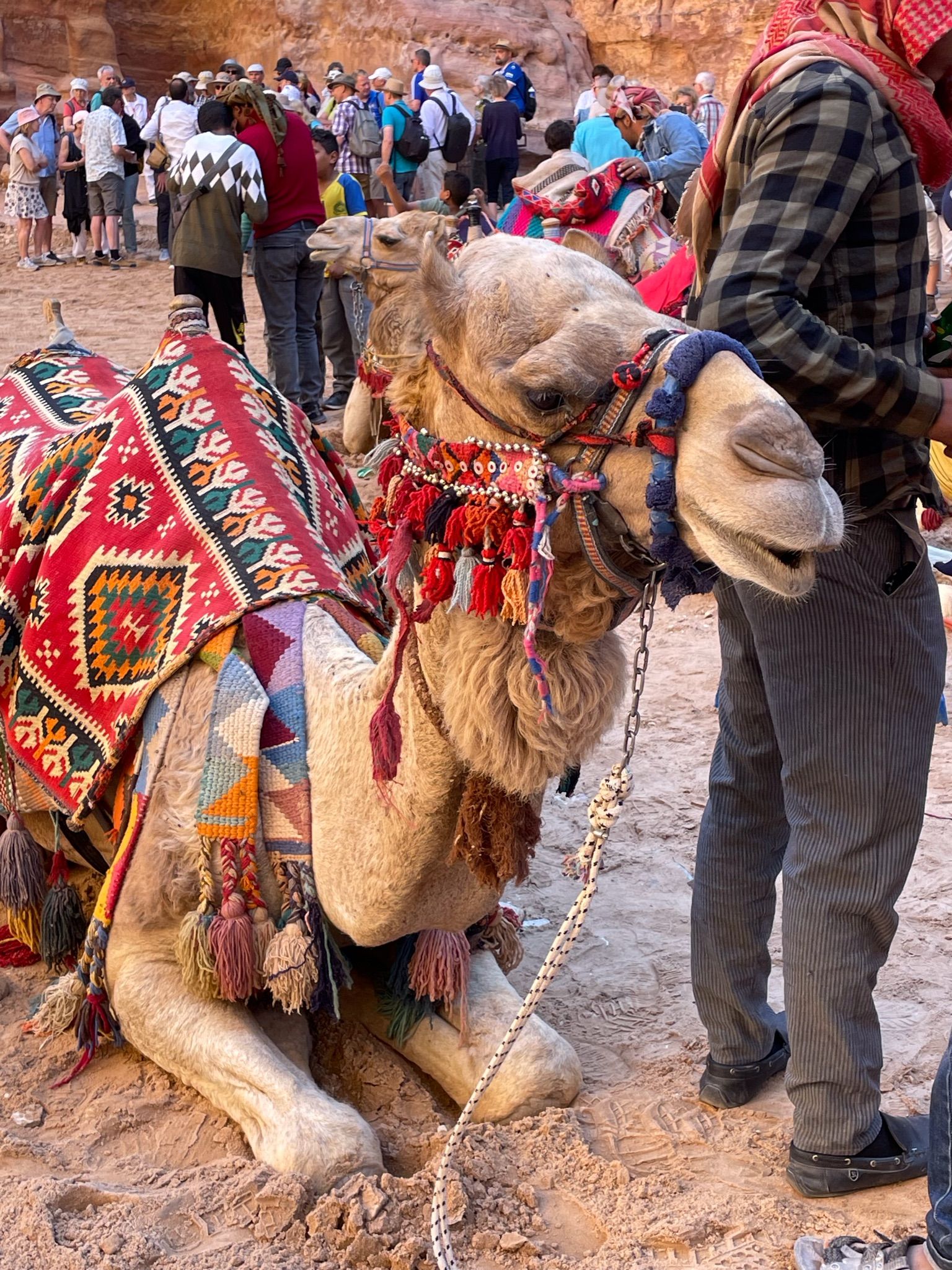
 We kept walking on the mostly resurrected stone path, sometimes walking over the original larger stones.
We kept walking on the mostly resurrected stone path, sometimes walking over the original larger stones. 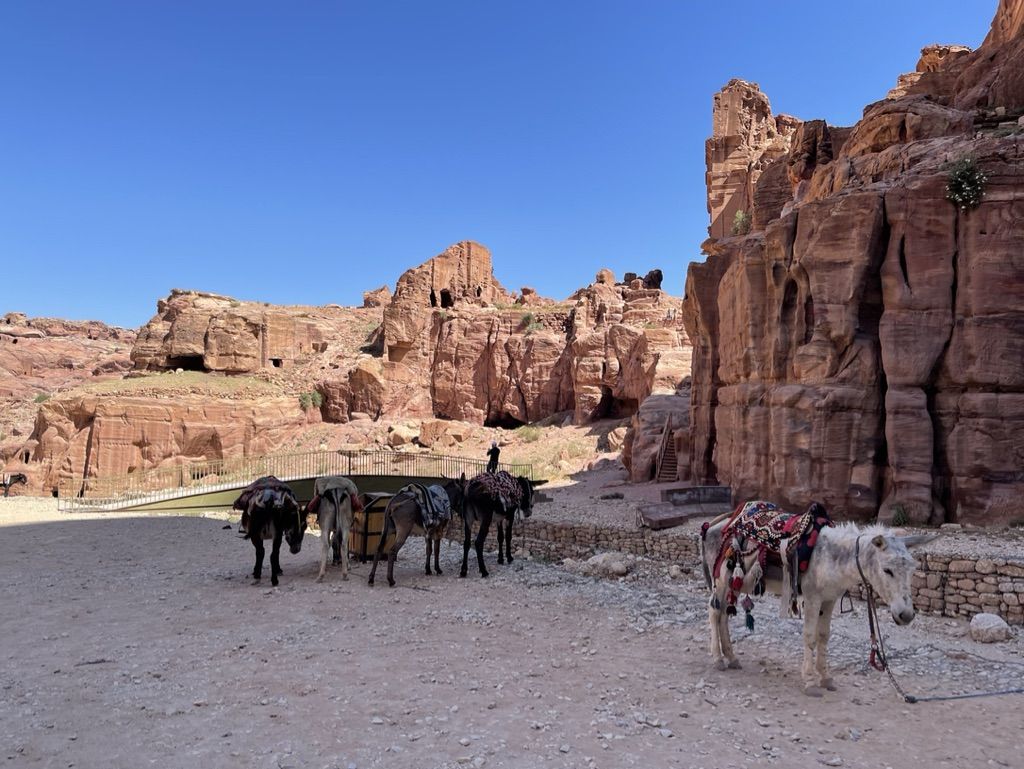
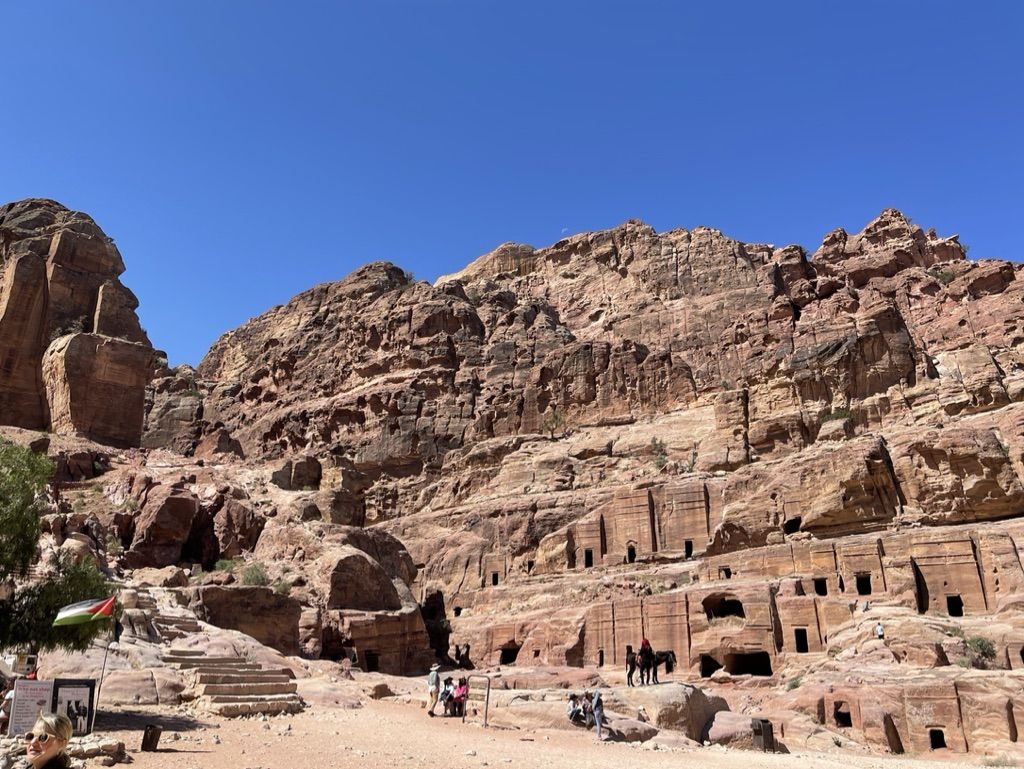 We passed the Theatre, the only theatre in the world carved into the side of the mountain, and after a long stretch, passed the Royal Tombs.
We passed the Theatre, the only theatre in the world carved into the side of the mountain, and after a long stretch, passed the Royal Tombs. 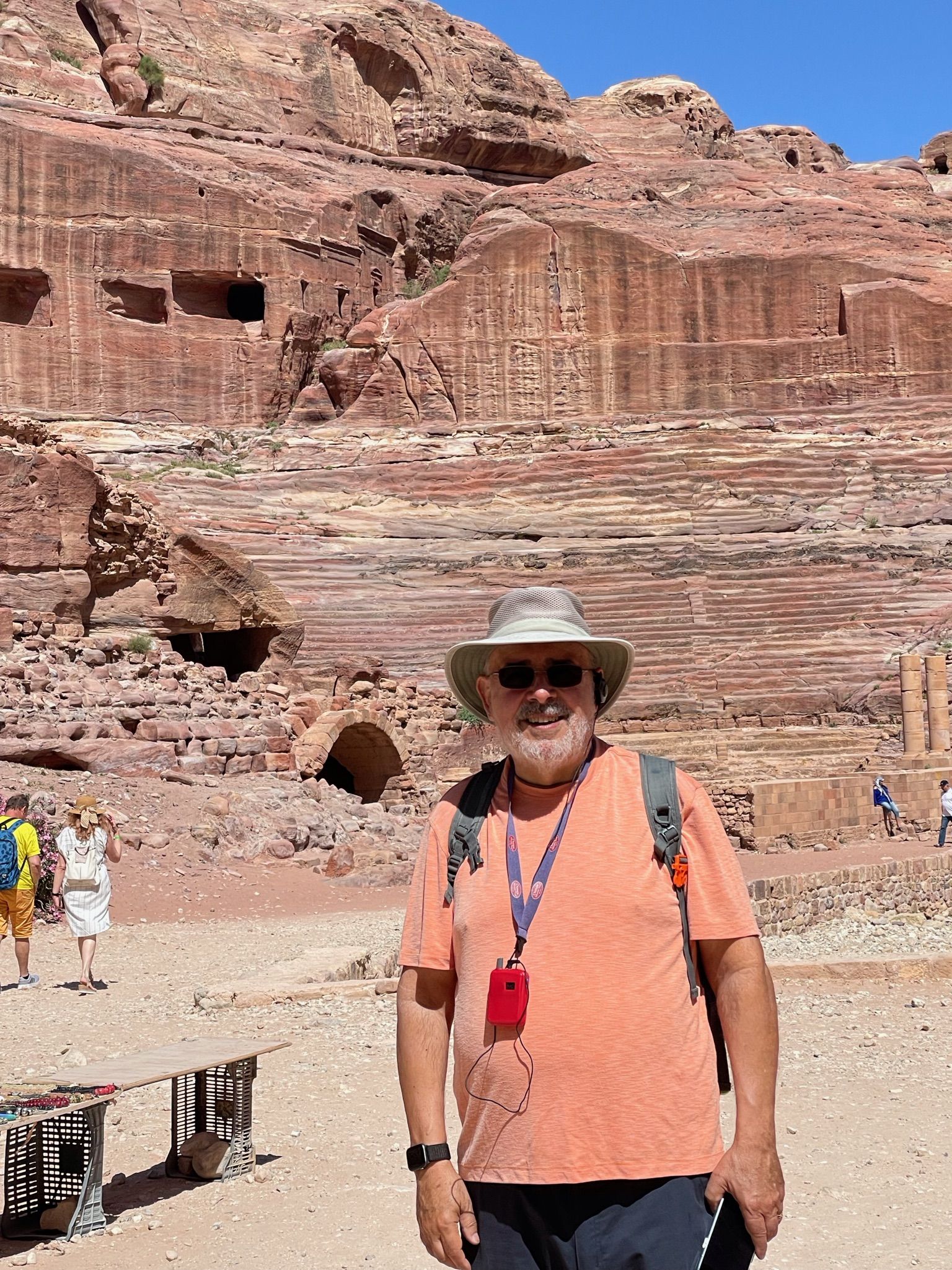
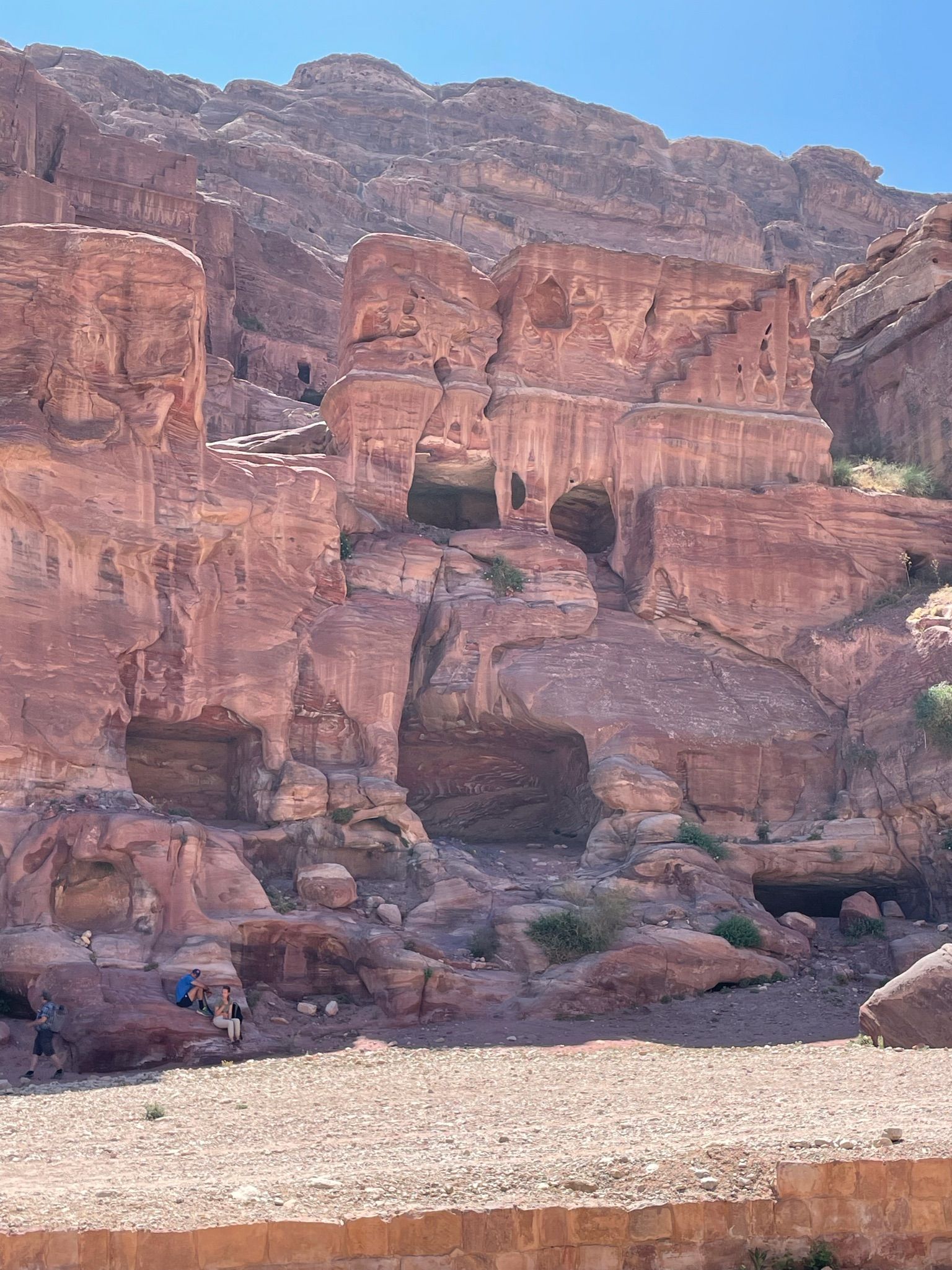
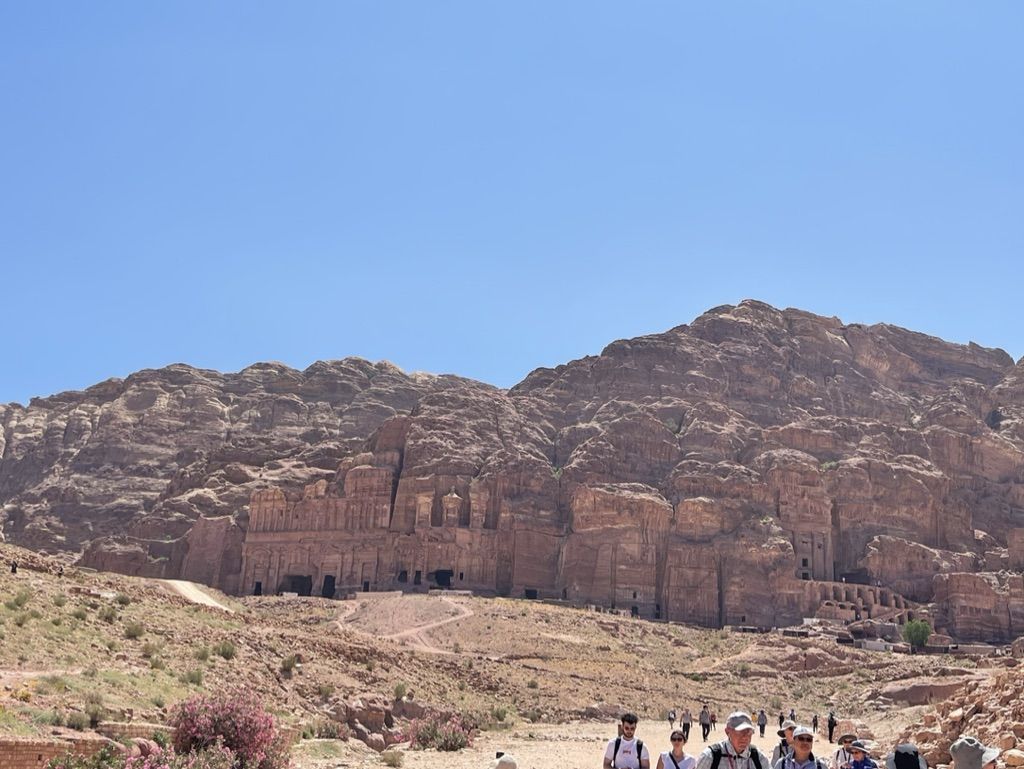 At this point we were about three miles in and pretty exhausted. We walked down the Colonnaded street just in time to arrive at our lunch destination, a huge restaurant that accommodated the hundreds of tourists.
At this point we were about three miles in and pretty exhausted. We walked down the Colonnaded street just in time to arrive at our lunch destination, a huge restaurant that accommodated the hundreds of tourists.  From this point, there are many trails (mostly unmarked) that meander through various sights. The most famous is the one that takes you straight up about 1.6 miles and over 850 steps to the Monastery, one of the largest buildings at Petra. Some of our hiking friends would try this in a heartbeat, but as we had 3-plus miles to walk for our return trip, we passed 😢😢.
From this point, there are many trails (mostly unmarked) that meander through various sights. The most famous is the one that takes you straight up about 1.6 miles and over 850 steps to the Monastery, one of the largest buildings at Petra. Some of our hiking friends would try this in a heartbeat, but as we had 3-plus miles to walk for our return trip, we passed 😢😢.
We opted instead to go back on an alternate trail that led us upwards to The Church, a Byzantine church probably built in the 5th century, and mostly destroyed by fire or earthquake in the following century. It does have a famously preserved mosaic floor. 
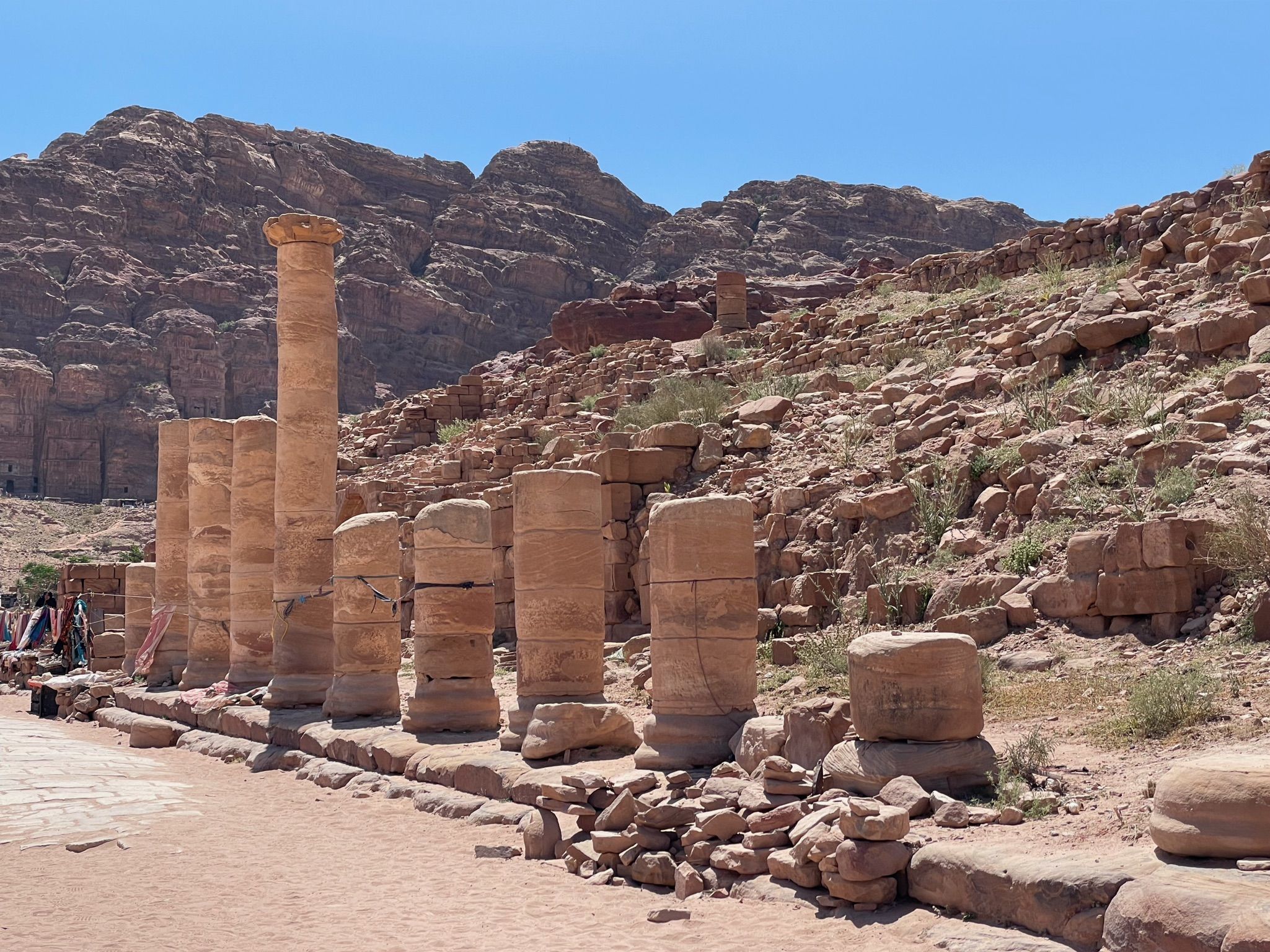
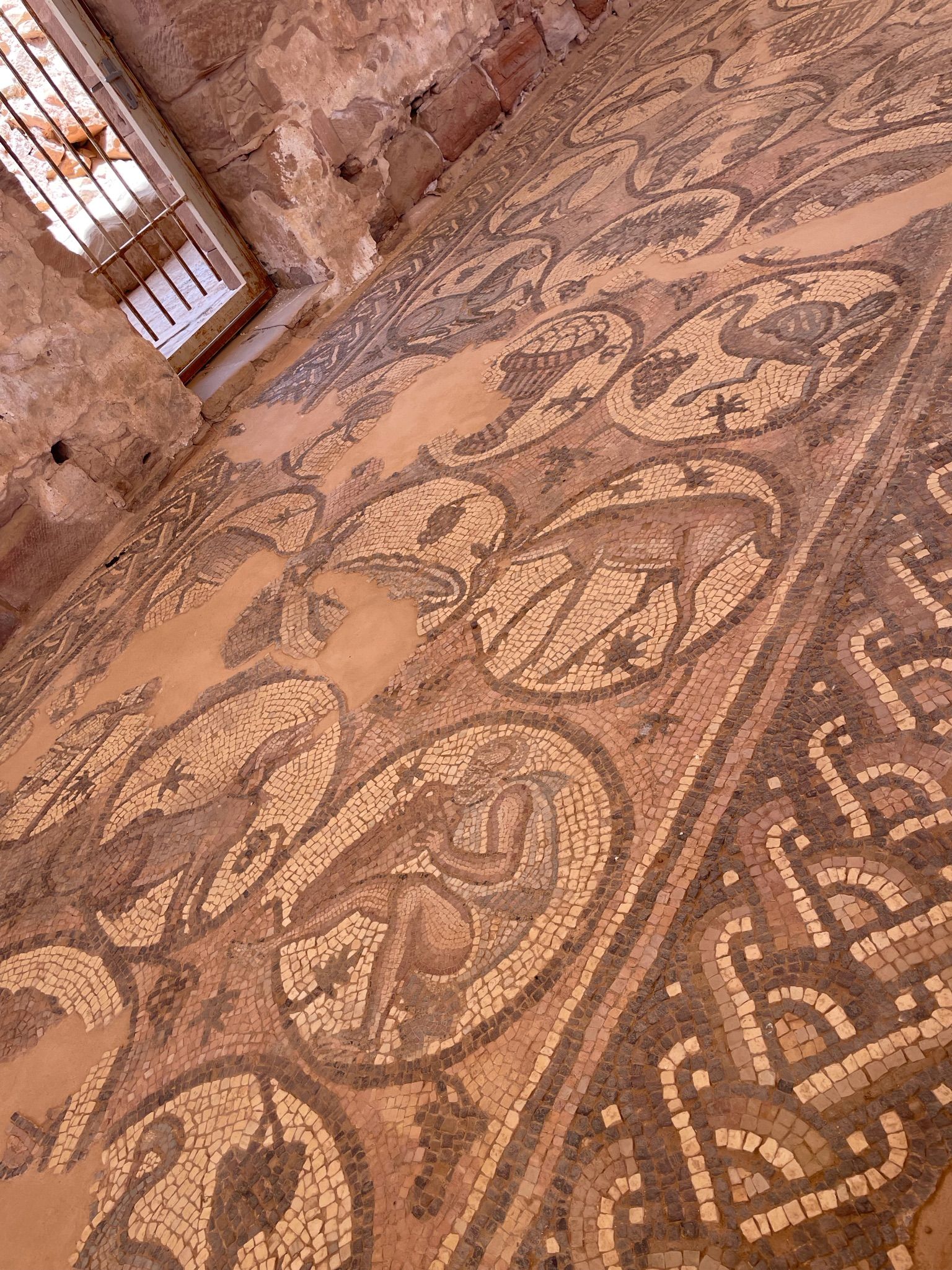 This path led us up close and personal to the four Royal Tombs (actually caves in the side of the mountain). We only went into the first one. Huge and empty, it was smelly with mold over the walls and ceiling. A fellow traveler reported a family of tribe members (who run the many stalls along the streets as well as providing the animals used for transportation) living inside one of other caves. Although illegal, some resist moving to the village built for them in the heights above Petra and prefer their
ancient ways.
This path led us up close and personal to the four Royal Tombs (actually caves in the side of the mountain). We only went into the first one. Huge and empty, it was smelly with mold over the walls and ceiling. A fellow traveler reported a family of tribe members (who run the many stalls along the streets as well as providing the animals used for transportation) living inside one of other caves. Although illegal, some resist moving to the village built for them in the heights above Petra and prefer their
ancient ways. 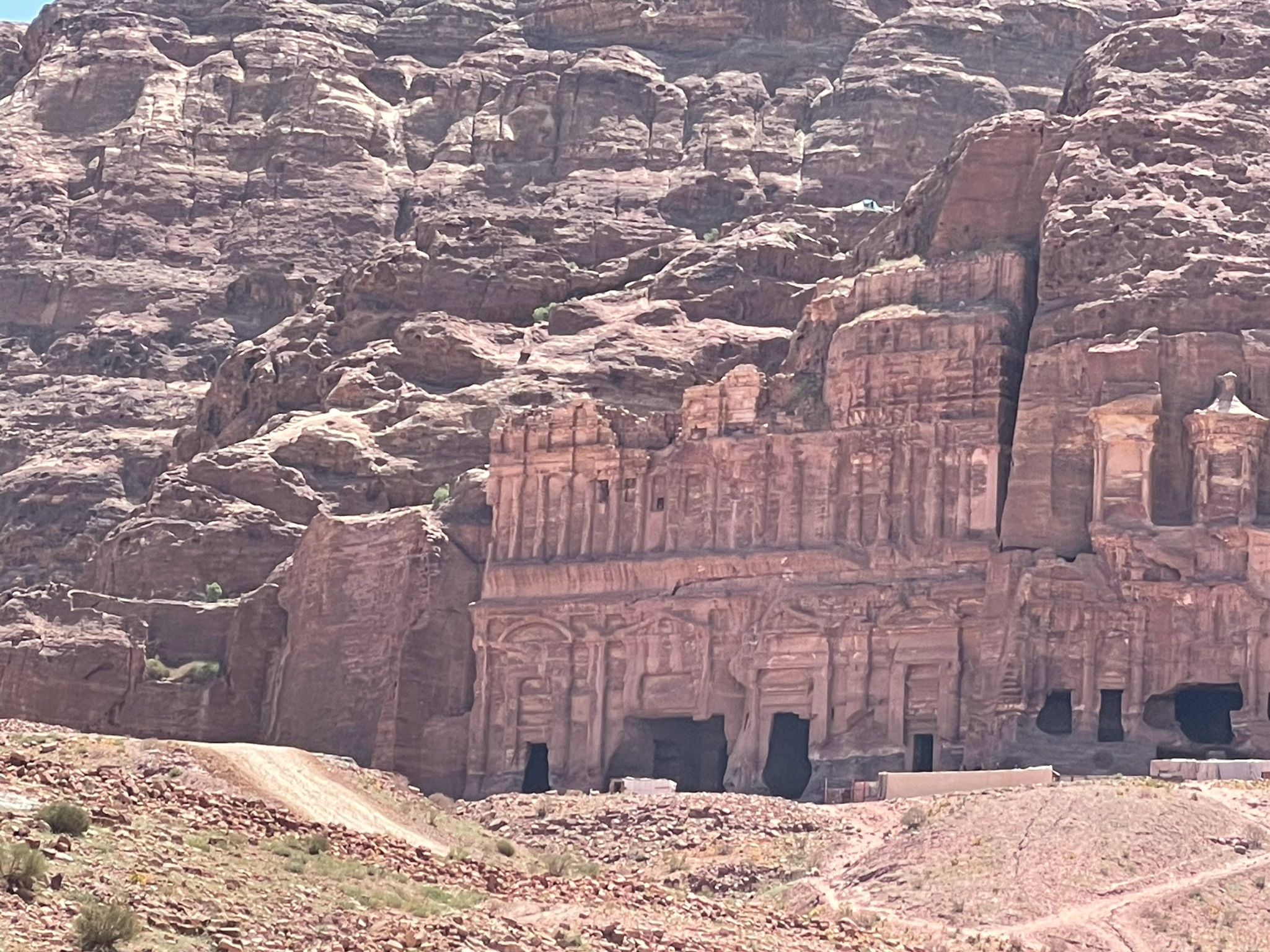
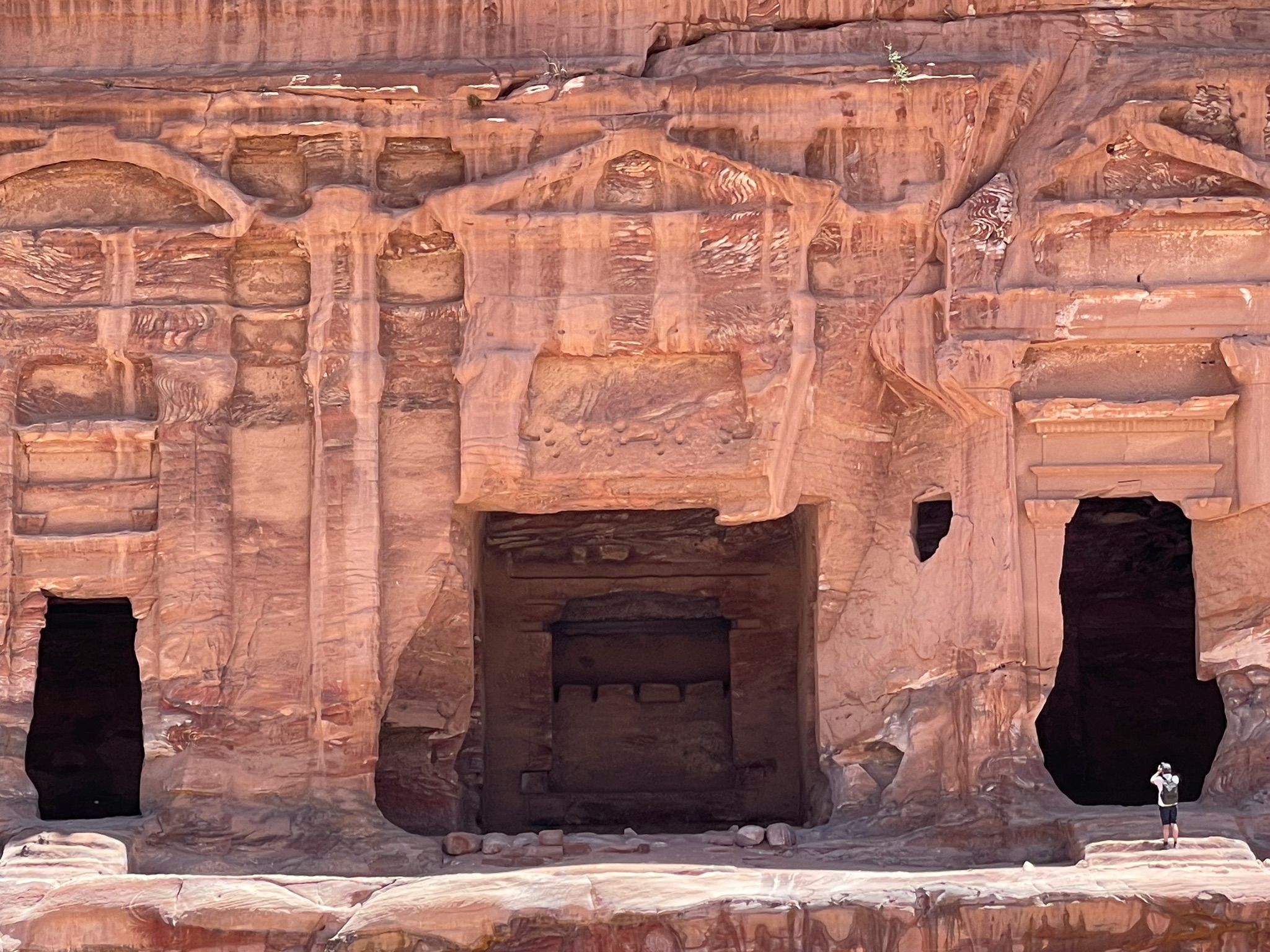
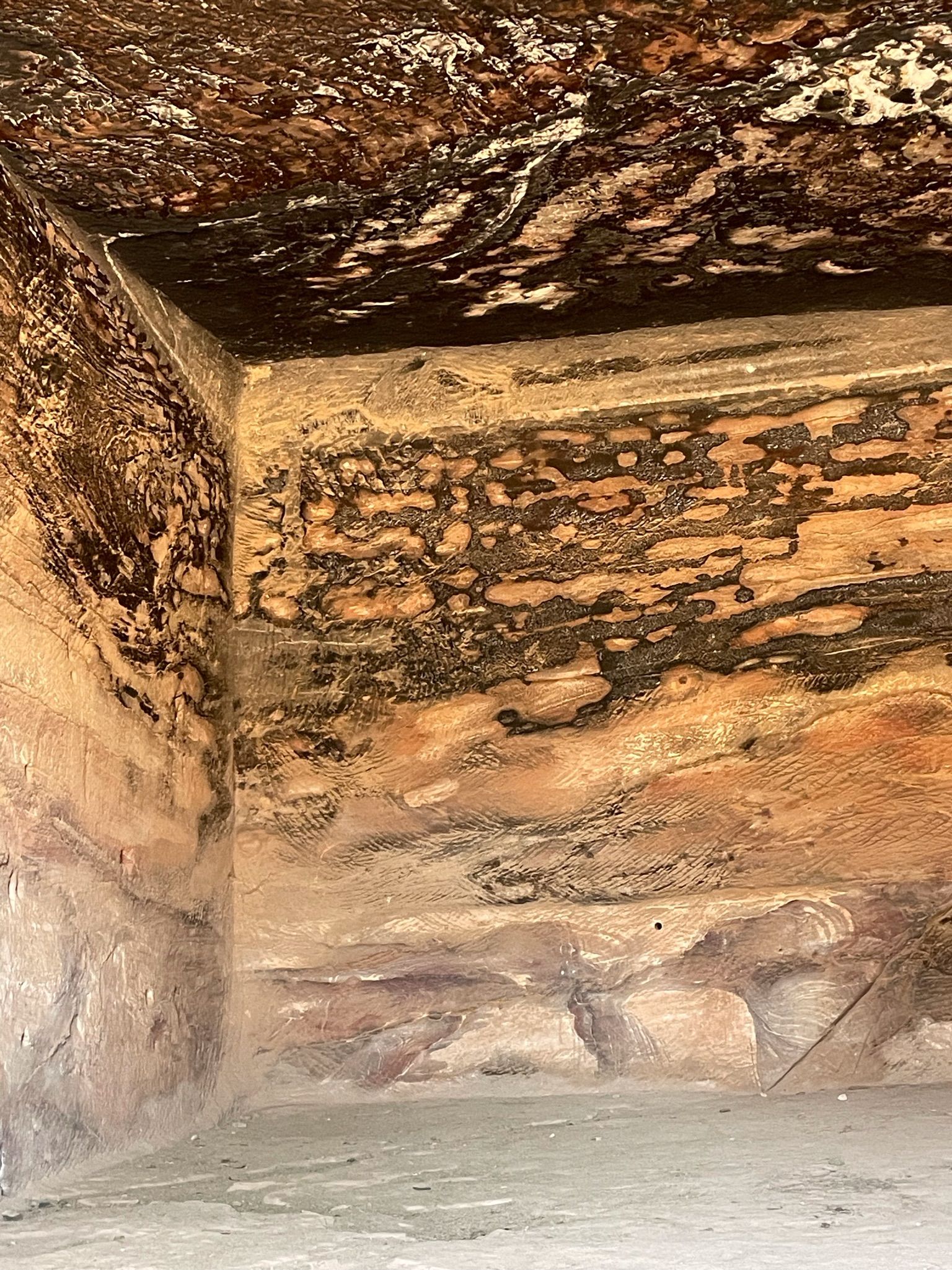
 The rest of the trip back was very slow. Wendy was so exhausted that she broke down and took a golf cart back. Although the weather was not too hot, the last two miles were all uphill and mostly in the mid-afternoon sun. Jim braved the trek and actually arrived back at the hotel before Wendy who had to wait 40 minutes for the golf cart!
The rest of the trip back was very slow. Wendy was so exhausted that she broke down and took a golf cart back. Although the weather was not too hot, the last two miles were all uphill and mostly in the mid-afternoon sun. Jim braved the trek and actually arrived back at the hotel before Wendy who had to wait 40 minutes for the golf cart!
These amazingly preserved structures of the Nabateans are truly one of a kind. Petra is a UNESCO world heritage site since 1975. Although getting more touristy with stalls, camel and donkey rides and, of course, hoards of people, the majesty of these remarkable structures is a testament to this fascinating civilization. 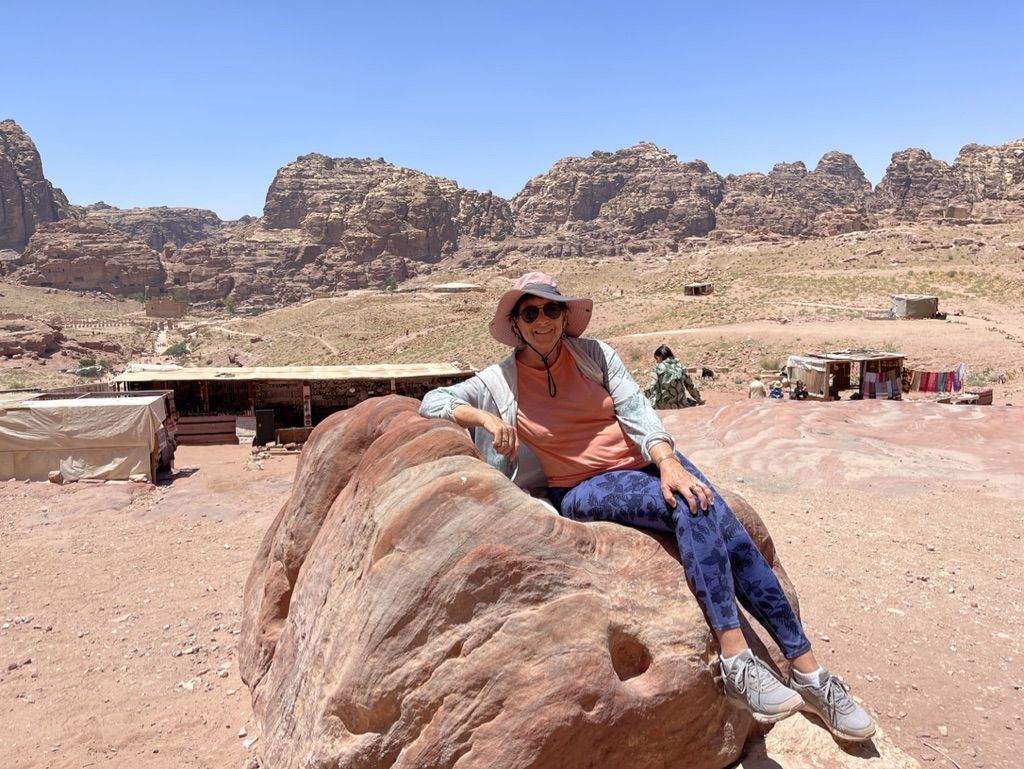 Previous
Previous
#published #evernote


 Our first rest stop was looking across the Jordan River Valley, posing on a homemade swing. The very primitive facilities were across the street. (Speaking of which, there are mostly western toilets here, but most with no tp except your own which never goes into the toilet but
into a side wastebasket. Hand drying, if there is enough water to wash is not unusual. Hotels are much better with good quality, and if you’re lucky, enough tp.
Our first rest stop was looking across the Jordan River Valley, posing on a homemade swing. The very primitive facilities were across the street. (Speaking of which, there are mostly western toilets here, but most with no tp except your own which never goes into the toilet but
into a side wastebasket. Hand drying, if there is enough water to wash is not unusual. Hotels are much better with good quality, and if you’re lucky, enough tp.  Along the King’s Highway, we passed camel caravans, trucks carrying fresh produce and saw small farms, settlements and the salt drying from the Dead Sea to make potash.
Along the King’s Highway, we passed camel caravans, trucks carrying fresh produce and saw small farms, settlements and the salt drying from the Dead Sea to make potash. 



 Patience was the word of the day. We arrived at the
Jordanian/Israeli border at the King Hussein bridge at about 11:15. In some ways, it reminded me of being in China where there were some kind of formalities many times over,with each government official or entity having its moment in the sun. Passports were collected three times.
Patience was the word of the day. We arrived at the
Jordanian/Israeli border at the King Hussein bridge at about 11:15. In some ways, it reminded me of being in China where there were some kind of formalities many times over,with each government official or entity having its moment in the sun. Passports were collected three times.


 Ibrahim, a native Arab Christian Israeli, has an intense style, very direct and concise and is not afraid to tackle any subject. He has already shared with us his thoughts on the political situation and the current attacks from Gaza into Israel. The media, on all sides, has been hyping this, but the rockets have all been destroyed by Israeli forces and a cease fire was declared two days ago.
But evidently it did scare away some tour groups who cancelled , so he thanked us for coming.
Ibrahim, a native Arab Christian Israeli, has an intense style, very direct and concise and is not afraid to tackle any subject. He has already shared with us his thoughts on the political situation and the current attacks from Gaza into Israel. The media, on all sides, has been hyping this, but the rockets have all been destroyed by Israeli forces and a cease fire was declared two days ago.
But evidently it did scare away some tour groups who cancelled , so he thanked us for coming. The ancient archeological city of Petra is located in southern Jordan about 300 kilometers south of Amman in the Al Sharah mountains. We left our hotel at 7 am and walked the 50 yards to the entrance— very nice!
The ancient archeological city of Petra is located in southern Jordan about 300 kilometers south of Amman in the Al Sharah mountains. We left our hotel at 7 am and walked the 50 yards to the entrance— very nice!  The first of hundreds of things that our guide Mohammad pointed out to us was way up— Aaron’s grave at the top of a huge hill. It is white. So, after seeing Moses’s last known place yesterday, Aaron’s today, my question to Mohammed was
The first of hundreds of things that our guide Mohammad pointed out to us was way up— Aaron’s grave at the top of a huge hill. It is white. So, after seeing Moses’s last known place yesterday, Aaron’s today, my question to Mohammed was  Petra (meaning
Petra (meaning 
 As we started our 6 mile walk through Petra, we passed hundreds of rock formations made more interesting by the streaks of morning sun hitting different sections.
As we started our 6 mile walk through Petra, we passed hundreds of rock formations made more interesting by the streaks of morning sun hitting different sections. 
 About ⅓ of a mile in, we reached a dam. A sophisticated system of aqueducts and pipes channeled water along the sides and sometimes above to deliver water to the city, but the dam was built to protect the valley from flash floods.
About ⅓ of a mile in, we reached a dam. A sophisticated system of aqueducts and pipes channeled water along the sides and sometimes above to deliver water to the city, but the dam was built to protect the valley from flash floods. 
 A narrow gorge called the Siq is 1.2 km long and presents a dramatic entry into the Treasury. It reminded us of Antelope Canyon in Arizona.
A narrow gorge called the Siq is 1.2 km long and presents a dramatic entry into the Treasury. It reminded us of Antelope Canyon in Arizona. 


 The Siq opens up into Petra’s most famous and magnificent structure called The Treasury, so named from a legend says that an Egyptian Pharaoh built it to house his treasure. It is almost 40 meters high and crowned by a funerary urn on top of the Corinthian columns. Even this early in the morning, it was packed with tourists, as well as donkeys, camels and golf carts to aid the weary travelers in getting to the other parts of the site. You might remember seeing it in
The Siq opens up into Petra’s most famous and magnificent structure called The Treasury, so named from a legend says that an Egyptian Pharaoh built it to house his treasure. It is almost 40 meters high and crowned by a funerary urn on top of the Corinthian columns. Even this early in the morning, it was packed with tourists, as well as donkeys, camels and golf carts to aid the weary travelers in getting to the other parts of the site. You might remember seeing it in 

 We kept walking on the mostly resurrected stone path, sometimes walking over the original larger stones.
We kept walking on the mostly resurrected stone path, sometimes walking over the original larger stones. 
 We passed the Theatre, the only theatre in the world carved into the side of the mountain, and after a long stretch, passed the Royal Tombs.
We passed the Theatre, the only theatre in the world carved into the side of the mountain, and after a long stretch, passed the Royal Tombs. 

 At this point we were about three miles in and pretty exhausted. We walked down the Colonnaded street just in time to arrive at our lunch destination, a huge restaurant that accommodated the hundreds of tourists.
At this point we were about three miles in and pretty exhausted. We walked down the Colonnaded street just in time to arrive at our lunch destination, a huge restaurant that accommodated the hundreds of tourists.  From this point, there are many trails (mostly unmarked) that meander through various sights. The most famous is the one that takes you straight up about 1.6 miles and over 850 steps to the Monastery, one of the largest buildings at Petra. Some of our hiking friends would try this in a heartbeat, but as we had 3-plus miles to walk for our return trip, we passed
From this point, there are many trails (mostly unmarked) that meander through various sights. The most famous is the one that takes you straight up about 1.6 miles and over 850 steps to the Monastery, one of the largest buildings at Petra. Some of our hiking friends would try this in a heartbeat, but as we had 3-plus miles to walk for our return trip, we passed 

 This path led us up close and personal to the four Royal Tombs (actually caves in the side of the mountain). We only went into the first one. Huge and empty, it was smelly with mold over the walls and ceiling. A fellow traveler reported a family of tribe members (who run the many stalls along the streets as well as providing the animals used for transportation) living inside one of other caves. Although illegal, some resist moving to the village built for them in the heights above Petra and prefer their
ancient ways.
This path led us up close and personal to the four Royal Tombs (actually caves in the side of the mountain). We only went into the first one. Huge and empty, it was smelly with mold over the walls and ceiling. A fellow traveler reported a family of tribe members (who run the many stalls along the streets as well as providing the animals used for transportation) living inside one of other caves. Although illegal, some resist moving to the village built for them in the heights above Petra and prefer their
ancient ways. 


 The rest of the trip back was very slow. Wendy was so exhausted that she broke down and took a golf cart back. Although the weather was not too hot, the last two miles were all uphill and mostly in the mid-afternoon sun. Jim braved the trek and actually arrived back at the hotel before Wendy who had to wait 40 minutes for the golf cart!
The rest of the trip back was very slow. Wendy was so exhausted that she broke down and took a golf cart back. Although the weather was not too hot, the last two miles were all uphill and mostly in the mid-afternoon sun. Jim braved the trek and actually arrived back at the hotel before Wendy who had to wait 40 minutes for the golf cart!